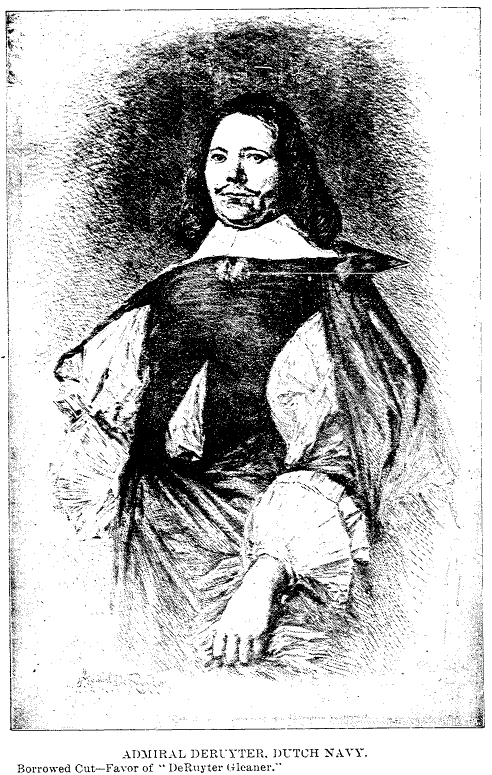


DeRuyter previous to 1795 was included in the ancient town of Whitestown, and formed a part of the famous "Lincklaen purchase." It was embraced in Cazenovia when that town was formed in 1795, and Col. John Lincklaen gave it the name of Tromptown; but when the act was passed by Legislature, March 15, 1798, authorizing the formation of a new town, and Col. Lincklaen named it DeRuyter, after his illustrious countryman. At an early date Col. Lincklaen opened two roads through his tract known as the east and west roads. The west road was laid out first and extended south from Cazenovia---Col. Lincklaen's home---all the way to German. The east road passed due south from Cazenovia over Crumb Hill,
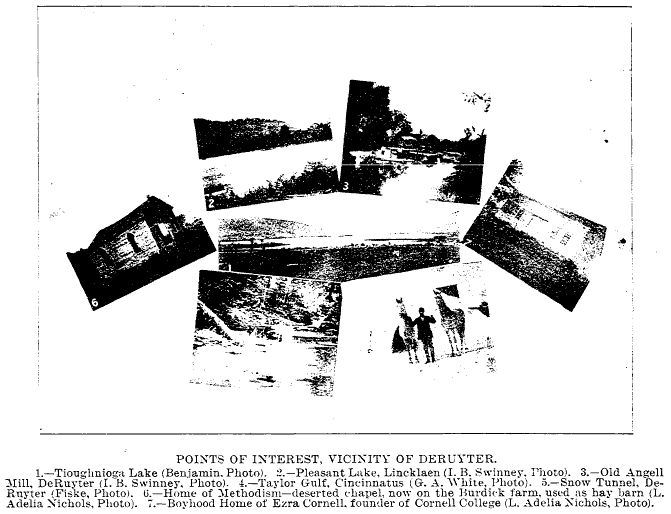
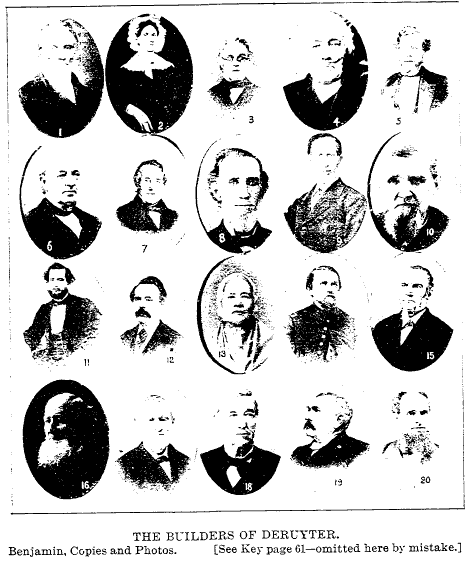 The Friends were always advocates of freedom and many others were sympathizers of the fugitive slaves and did all they could to send them north to safety and liberty. During the great Rebellion DeRuyter furnished a noble band who fought under the Stars and Stripes, many of whom died for their country, and not a few suffered in rebel prisons and a few are left to recount the hardships of camp and battlefield. The building of the "Midland" railroad through DeRuyter and the heavy bonding of the town and corporation eventually brought financial difficulties, but the "Adjustment" of 1887 relieved this anxiety and the corporation is now paying off its debts and trade and prosperity are coming back to the village. DeRuyter village was first incorporated April 15, 1833, and again in the years 1847 and 1878, and has an efficient health board and an effective fire department. More than a century has passed since DeRuyter village was first located in the charming valley of the Tioughnioga and its century of successes and failures have made their impress upon three generations of noble men and women. Worthy sons and daughters have grown up, and many of them enjoyed the excellent advantages of its schools and went out to do larger work and receive the larger honors and rewards that followed. Many more remained at home to follow the quiet round of labors and sufferings, and to them should be given the honor largely for what DeRuyter has been and is.
The Friends were always advocates of freedom and many others were sympathizers of the fugitive slaves and did all they could to send them north to safety and liberty. During the great Rebellion DeRuyter furnished a noble band who fought under the Stars and Stripes, many of whom died for their country, and not a few suffered in rebel prisons and a few are left to recount the hardships of camp and battlefield. The building of the "Midland" railroad through DeRuyter and the heavy bonding of the town and corporation eventually brought financial difficulties, but the "Adjustment" of 1887 relieved this anxiety and the corporation is now paying off its debts and trade and prosperity are coming back to the village. DeRuyter village was first incorporated April 15, 1833, and again in the years 1847 and 1878, and has an efficient health board and an effective fire department. More than a century has passed since DeRuyter village was first located in the charming valley of the Tioughnioga and its century of successes and failures have made their impress upon three generations of noble men and women. Worthy sons and daughters have grown up, and many of them enjoyed the excellent advantages of its schools and went out to do larger work and receive the larger honors and rewards that followed. Many more remained at home to follow the quiet round of labors and sufferings, and to them should be given the honor largely for what DeRuyter has been and is.
DeRuyter's Distinguished Sons---The early settlers of the town and village were of New England origin, with their zeal for education, and DeRuyter from its beginning has been conspicuous as an educational center. David Maine was a noble teacher, who trained the youth at the "Burdick school," near the reservoir, and Paul Chase, a rare educator in DeRuyter and elsewhere, with many others, were conspicuous as teachers in those early days and prepared the way for the educational facilities that were to follow. The DeRuyter institute inaugurated by the Seventh Day Baptists and the heartily patronized by the Presbyterians, Friends and others, was founded in 1836, and has done a marvelous work for higher education through all the country. Is it then to be wondered at, that DeRuyter should have sent forth so many who have distinguished themselves---Ezra Cornell, the founder of Cornell University; Gen. Ladock T. Bently, jurist and lawyer; David J. Mitchell, lawyer; P. A. Burdick, temperance orator and evangelist; Hon. John F. Benjamin, M. C., of Missouri; Hon. Henry C. Goodwin, M. C., N. Y.; Hon James W. Nye, U. S. Senator, Nevada; Henry D. Maine, editor of the Rochester Democrat and Chronicle; Lyman J. Gage, Secretary of the Treasury, Washington, D. C.; Benjamin Enos, Canal Commissioner and Treasurer, New York State, and many, many others.
Tioughnioga Lake and Early Settlers---Although this little lake is an artificial one, it successfully vies in beauty with any of the numerous lakelets which adorn the landscape of northern and central New York. The deep valley in which it is ensconsed, the splendid range of hills which rise abruptly from its western edge, the more undulating character of the hilly region on its eastern shore, the picturesque gorge through which it waters flow northward; as well as the fine farming country stretching southward to the village of DeRuyter, all contribute to make this sheet of water most charming. It is difficult to find a more delightful drive in the Empire State than that from DeRuyter village around this gem of a lake---a distance of about eleven miles. The lake is nearly two miles in length; about three-quarters of a mile across in its widest part, and covers nearly 630 acres. The average depth of the water is 18 ½ feet, although at the center of the dam, it has a depth of over 70 feet. The lake affords excellent fishing and boating and has begun to attract not only picnic excursionists but permanent summer boarders as well. There is no reason why it should not develop into a popular summer resort.
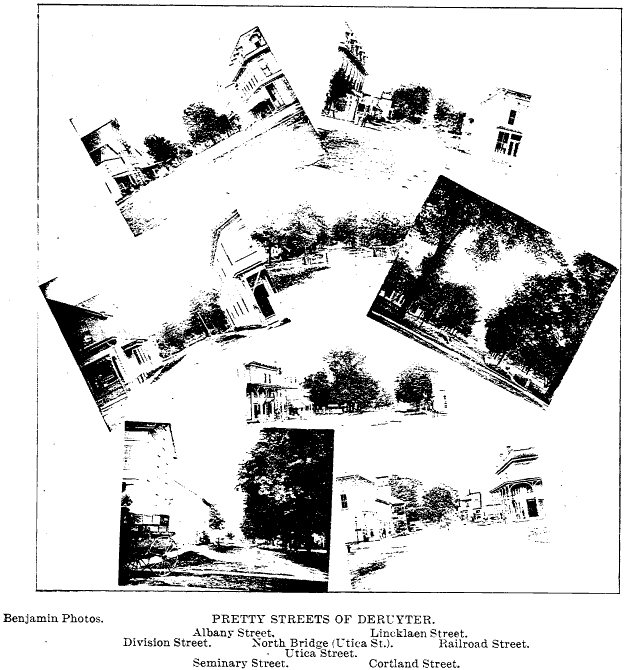
Prior to 1861-2, when the lake was constructed as a storage reservoir for the supply of the Erie canal, its bed and shore were parcelled out into many farms. Near its southwest corner, one of the earliest settlers in this part of the state---Eli Colegrove---located in 1793. During the same year, Elias, Chester and Elijah Benjamin settled within the present limits of the town; and it was the boast of Mrs. Colegrove that she and Mrs. Elijah Benjamin were the first white women to live within the present boundaries of DeRuyter. The Colegrove farm at an early day passed into the ownership of Bradley Merchant, who settled near by soon after 1800, and whose son, Benjamin F. Merchant, continues to occupy it with several other primitive holdings, which he has brought together into a large landed estate. Two other sons of Bradley, J. Warren and M. R. Merchant, were for many years leading business men of DeRuyter village. The former was also prominent in local and state politics and affairs, holding the offices of supervisor and member of assembly, as well as being director of the Midland Railroad company. In 1794, Thompson Burdick, at the age of twenty-three, made a trip on horseback from Westerly, R. I., and contracted for upwards of one hundred and seventy acres to the south and east of the lake. He made a small clearing in the forest, and sowed some winter wheat, before returning to his native state; and the following year, with his young bride, settled upon his new farm. They had made the journey in true immigrant style, with oxen, horses, cows and household goods; the trip occupying about six weeks, and the last stage of it from Oneida, being unusually arduous, as no road had been constructed and they were forced to find their way through the forests by means of blazed trees. Their primitive log cabin was built near a bountiful spring on the west side of the present highway, and not far from the present residence of his grandson, B. Franklin Burdick. A year or two later, Thompson sold the north half of his original farm to his brother William, who had married a sister of Thompson's wife; the latter being also a sister of Mrs. Eli Colegrove. This portion of the farm descended to Kenyon Burdick, a son of William, who sold it to William F. Wall, its present owner. It is believed that David C. Burdick, the oldest son of Thompson, was the first white child born in DeRuyter, his birthday being May 25, 1796. The Thompson Burdick farm descended to a son, Albert G., who added several primitive holdings, one of which was taken up by George Coon, to the north of David Maine's house and another was a part of the Caleb Smith farm. During his early life, he was prominent in the state militia, gaining the rank of captain. One of the commissions issued to him---as second lieutenant of the 15th Regiment of Artillery---bears the date of Oct. 12, 1835, and the signature of Gov. W. L. Marcy. He married Eunetia Y. Wheeler of Nelson, Madison Co. Their children were: Catherine P., wife of Leonard R. Green of Adams Center, N. Y.; Frances M., Dwight, professor of law in Columbia University, whose summer residence is on the Smith addition to the Burdick farm; P. Adelbert, lawyer and eminent temperance evangelist, who died in 1893, and B. Franklin, who owns and occupies the old homestead.
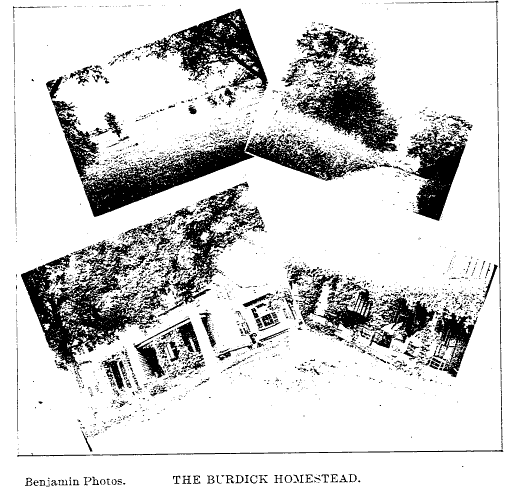
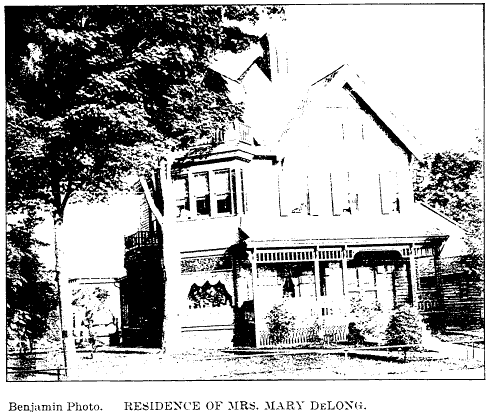
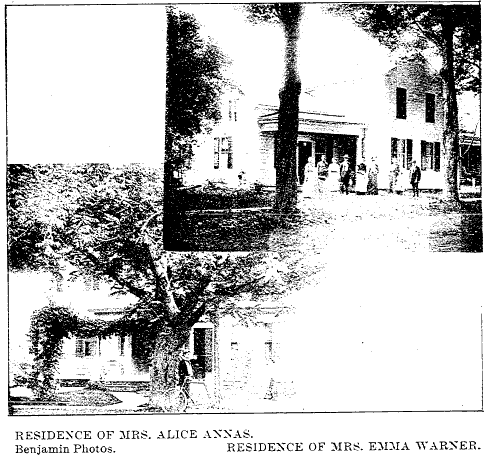
For many years they occupied the original Enos farm, which is now owned by LeRoy Vincent. One of their sons, Charles B., is president of a successful printing press manufactory in New London, Conn., and with him they now reside. The other son, Henry D., a graduate of DeRuyter institute and Amherst college, a teacher and preacher of brilliant promise, died in 1891. At the northeast corner of the lake settled Pardon Coon, a brother of Jonathan. The farm is now owned by Myron W. Coon of Syracuse, who with his family, returns to the old homestead for the summer vacation. One of his sons, Percy, a rising young business man of Syracuse, has built an attractive summer cottage not far from his father's house; and the other son, Clarence, a promising Syracuse physician, plans to build near by in the immediate future. Among the early settlers on the west side of the lake was Oliver Crandall and Eleazor Sweetland. The latter's son, Ethan, still occupies that part of the Sweetland farm which was not submerged. At a little distance to the south of the lake settled David Maine, Sr., a wheelwright and chair maker, whose son David Maine, Jr., a teacher, surveyor and local as well as state official of eminence, occupied the farm until his death, when it descended to his sons, Henry C. and Irving. Upon the death of the latter, it passed into the possession of Mrs. DeLacy Benjamin, who still owns it. Henry C. Maine, after graduating from DeRuyter institute and Hamilton college, devoted himself to newspaper and literary work, in which he has achieved an excellent reputation. While proprietor of the Troy Whig, he employed as one of his assistants Ex-Gov. Black, who had just finished his college course. For a number of years, Mr. Maine has been connected with the Rochester Democrat. His discussion of the sun's spots, and his weather predictions, founded upon his observations of the sun's surface, have demonstrated his capacity as a man of original scientific thought. In the year 1800, Matthew Wells, Sr., took up a farm of more than two hundred acres, to the southeast of the Thompson Burdick farms, being led to this locality because several sisters of his wife, Mrs. Thompson Burdick and others were living here. His son, Matthew Wells, Jr., after a long and successful life on the farm, sold it to William Hunt, whose son James now owns the place. More than half a century ago Mr. Wells built a machine shop on the branch of the Tioughnioga which ran through his farm and which was turned from its natural course a short distance below the shop to become the principal source of supply for the lake when that was constructed. The shop was run by his son Welcome, until his death, when the Cardner Bros. took it and for many years did an extensive business in manufacturing cheese boxes and horse rakes. Theirs was one of the first cheese-box manufactories in the state. They were succeeded by Charles R. Maxson, a son-in-law of Mr. Wells, who in 1864 transferred the business to Kenyon Muncy and Oscar Crandall. After a few months, Crandall sold out to Dennis T. Coon, who with his brother, J. Avery, has continued in possession of the premises to the present time. The original DeRuyter settlers acquired title to their lands from John Lincklaen and others, who purchased in 1792, for the Holland Land company, a tract of 120,000 acres, which included the present towns of German, Pitcher, Lincklaen, DeRuyter, Nelson and a part of Cazenovia. In the deed to Thompson Burdick, of May 1, 1795, the grantors are John Lincklaen of the county of Herkimer, and Herman LeRoy, of the city of New York. It is witnessed by Jonathan Foreman and Samuel S. Foreman and recorded Nov. 16, 1796, in the clerk's office of Herkimer county, as neither the town of DeRuyter nor the county of Madison had then been organized. The price of the 172 acres 2 roods and 16 perches conveyed was, "Two hundred and thirty-seven pounds, twelve shillings and ten pence, current money of the State of New York." In Jonathan Coon's deed of 1801, the price of his hundred acres is named as $300---while eleven years later he paid $300 for 50 acres adjoining his earliest purchase. During the first quarter of the nineteenth century the population of DeRuyter increased with marvelous rapidity. In 1795 there were only a few families within the present limits of the town; while from 1820 to 1830 the attendance of pupils during the winter terms in school district No. 3, (which surrounds the lake) exceeded one hundred. At present the number of children of school age in the district is less than thirty. In the earlier period small land holdings and large families were the rule. Now the tendency is towards small families and big farms.
FRANCIS M. BURDICK
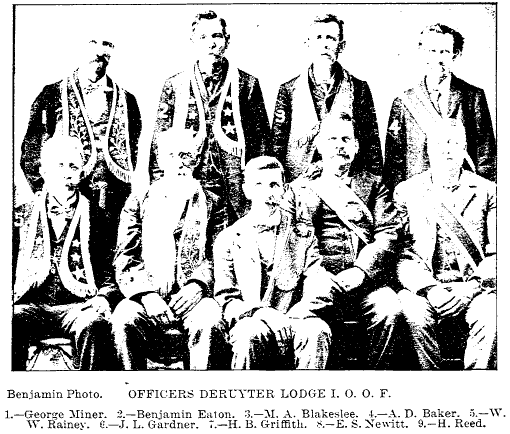 The Seventh Day Baptist Church---Quite a colony of Seventh Day people came to DeRuyter from Rensselaer county and on Sept. 29, 1806, a council composed of Elder Henry Clark and Deacon Phineas Burdick, from Brookfield, and Elder William Satterlee, Deacon Jabes Burdick, Stephen Maxson and Eliphaleh Johnson, from Petersburg, Rensselaer Co., organized the Seventh Day Baptist church of DeRuyter (then Cazenovia) with 23 members, 14 of whom were dismissed from the Petersburg church and 9 were from DeRuyter and vicinity. They then ordained David Davis evangelist elder. In the many changes that followed in those early days the church records are not complete, but in 1815 the church was reorganized and the minutes faithfully kept and the meetings regularly maintained. The Sabbath services were often held at the settlement at German (now Lincklaen Center) and at Truxton (now Cuyler Hill) where at each place there was a large and prosperous Sabbath keeping community as early as 1815. In 1827 the membership had reached 177 and during this year the Seventh Day Baptist church of Truxton was constituted with members dismissed from DeRuyter. During the autumn of 1831 the Seventh Day Baptist church of Lincklaen was organized with members likewise dismissed from DeRuyter. From 1825 to 1830 the mother church was supplied by visiting ministers and from 1830 to 1835 Elders Alexander Campbell, Joel Green and Ephraim Curtis followed the itinerant plan. About 1835 the church edifice in the village was erected at a cost of $3000, and so substantially was it built that it has stood for 65 years with slight repairs, and now plans are in contemplation to modernize and improve it. During the 94 years of the church's existence there has been 16 pastors and ministers, many of whom were men of fine culture and signal ability. Among these may be mentioned Alexander Campbell, the founder of DeRuyter institute and a man of rare ability and spiritual power; Elder James R. Irish, so long the principal of DeRuyter institute and a giant in body, mind and heart; Elder Geo. E. Tomlinson, a brilliant, classical scholar and orator, and Elder Joshua Clark, so successful as pastor and evangelist through all this section. The great length of many of these pastorates speaks well for the ability of the ministers and thr cooperation of the membership. The largest membership was during the prosperity of the
The Seventh Day Baptist Church---Quite a colony of Seventh Day people came to DeRuyter from Rensselaer county and on Sept. 29, 1806, a council composed of Elder Henry Clark and Deacon Phineas Burdick, from Brookfield, and Elder William Satterlee, Deacon Jabes Burdick, Stephen Maxson and Eliphaleh Johnson, from Petersburg, Rensselaer Co., organized the Seventh Day Baptist church of DeRuyter (then Cazenovia) with 23 members, 14 of whom were dismissed from the Petersburg church and 9 were from DeRuyter and vicinity. They then ordained David Davis evangelist elder. In the many changes that followed in those early days the church records are not complete, but in 1815 the church was reorganized and the minutes faithfully kept and the meetings regularly maintained. The Sabbath services were often held at the settlement at German (now Lincklaen Center) and at Truxton (now Cuyler Hill) where at each place there was a large and prosperous Sabbath keeping community as early as 1815. In 1827 the membership had reached 177 and during this year the Seventh Day Baptist church of Truxton was constituted with members dismissed from DeRuyter. During the autumn of 1831 the Seventh Day Baptist church of Lincklaen was organized with members likewise dismissed from DeRuyter. From 1825 to 1830 the mother church was supplied by visiting ministers and from 1830 to 1835 Elders Alexander Campbell, Joel Green and Ephraim Curtis followed the itinerant plan. About 1835 the church edifice in the village was erected at a cost of $3000, and so substantially was it built that it has stood for 65 years with slight repairs, and now plans are in contemplation to modernize and improve it. During the 94 years of the church's existence there has been 16 pastors and ministers, many of whom were men of fine culture and signal ability. Among these may be mentioned Alexander Campbell, the founder of DeRuyter institute and a man of rare ability and spiritual power; Elder James R. Irish, so long the principal of DeRuyter institute and a giant in body, mind and heart; Elder Geo. E. Tomlinson, a brilliant, classical scholar and orator, and Elder Joshua Clark, so successful as pastor and evangelist through all this section. The great length of many of these pastorates speaks well for the ability of the ministers and thr cooperation of the membership. The largest membership was during the prosperity of the 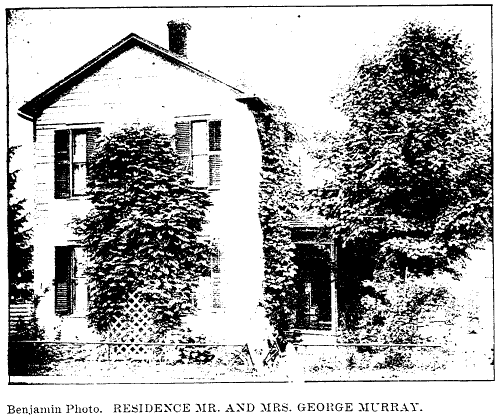 DeRuyter Institute from 1836 to 1870, when large numbers of students were added, being gathered in during great revivals. The present membership is 140, of whom quite a number live at a distance and great numbers have moved west and helped organize other churches. Rev. Joshua Clark, a successful preacher and evangelist, was pastor nearly 17 years, from January, 1870, till into 1886, and gathered large numbers into the church.
DeRuyter Institute from 1836 to 1870, when large numbers of students were added, being gathered in during great revivals. The present membership is 140, of whom quite a number live at a distance and great numbers have moved west and helped organize other churches. Rev. Joshua Clark, a successful preacher and evangelist, was pastor nearly 17 years, from January, 1870, till into 1886, and gathered large numbers into the church.
Rev. L. R. Swinney, the present pastor, followed in the autumn of that year and has continued till the present (1900). He was born in Bridgeton, New Jersey, educated in his native state and taught during the Civil War, (1860-65) near Gettysburg, and entered Union Theological seminary, N. Y. city, in 1866, and graduated in the class of 1869, making a specialty of the oriental languages. In November of that year he was married to Miss Sue M. Black, of Black's Gap, Pa,, and settled as pastor at Alfred, N. Y., and elected professor of Hebrew and Cognate languages in Alfred university. In 1877, he went to West Virginia and was pastor and missionary for nine years in that state and Kentucky. In 1886 he moved back to N. Y. and settled at DeRuyter on account of its educational advantages. Following a missionary plan he preaches in many of the adjacent neighborhoods and has organized and for the past six years conducted at Sherman Park, Syracuse, a mission on the plan of the Young Men's Christian Association. He is also treasurer of the County Sunday-school association and president of the Madison Co. Bible society.
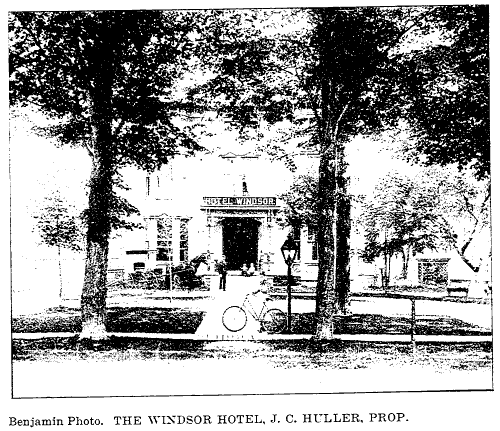 Tioughnioga Lodge No. 552, I. O. O. F., was instituted at DeRuyter, N. Y., on the 13th day of May, 1889, by D. D. G. M. George W. Chapman, of Canastota, with six charter members as follows: J. R. Coye, N. G.; S. L. Porter, V. G.; A. L. Baker, Sec; W. J. Hodges, P. S.; Giles Coye, Treas.; H. J. Reed, I. G. In the evening seventeen members received the three degrees, McGrawville lodge, No. 320, working the initiatory and second, and Pleasant Valley lodge, No. 421, of Delphi, the first and third degrees. During the ten years of its existence to Dec. 31, 1899, it has worked the degrees on over one hundred members and has paid in benefits and donations in the aggregate of $600. The seven following members have died: E. P. Brown; B. J. Brown, L. R. Grant, David Evens, G. M. Foster, Charles E. Beakman, J. H. Babcock. There have been four new lodges formed, taking thirteen members from the lodge. The membership Dec. 31, 1899, was fifty-four, of which twelve are Past Grands.
Tioughnioga Lodge No. 552, I. O. O. F., was instituted at DeRuyter, N. Y., on the 13th day of May, 1889, by D. D. G. M. George W. Chapman, of Canastota, with six charter members as follows: J. R. Coye, N. G.; S. L. Porter, V. G.; A. L. Baker, Sec; W. J. Hodges, P. S.; Giles Coye, Treas.; H. J. Reed, I. G. In the evening seventeen members received the three degrees, McGrawville lodge, No. 320, working the initiatory and second, and Pleasant Valley lodge, No. 421, of Delphi, the first and third degrees. During the ten years of its existence to Dec. 31, 1899, it has worked the degrees on over one hundred members and has paid in benefits and donations in the aggregate of $600. The seven following members have died: E. P. Brown; B. J. Brown, L. R. Grant, David Evens, G. M. Foster, Charles E. Beakman, J. H. Babcock. There have been four new lodges formed, taking thirteen members from the lodge. The membership Dec. 31, 1899, was fifty-four, of which twelve are Past Grands.
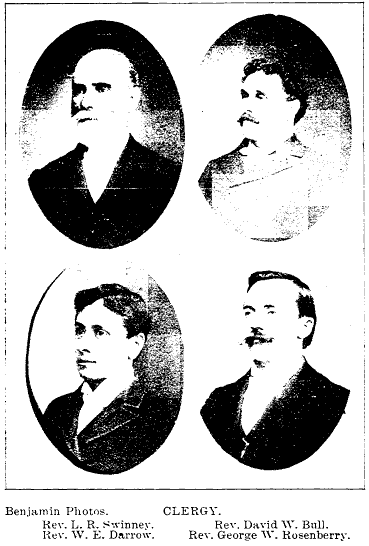 The Rebekahs---At a special meeting called at Odd Fellows hall on the evening of Feb. 23, 1894, for the purpose of instituting a lodge of Rebekahs in DeRuyter, N. Y., D. D. G. M. Mrs. Emma J. Moody of Oneida instituted Violetta No. 11, D. of R., with the following charter members: A. L. Baker, Mrs. Sarah E. Baker, John Snell, Mrs. Addie Snell, B. F. Eaton, Mrs. Sarah A. Eaton, E. W. Schelinger, Mrs. Polley Kelley, W. J. Hodges, T. T. White; after which seven candidates received the degree. The membership on Dec. 31, 1899, was fifty-three with the following officers: Presiding N. G., Mrs. Mary Swind; V. G., Mrs. Ella J. Griffith; Sec., A. L. Baker; Treas., Mrs. Sylvia S. Hodges; Past Noble Grands, Mrs. Emily Brown, Mrs. Addie Snell.
The Rebekahs---At a special meeting called at Odd Fellows hall on the evening of Feb. 23, 1894, for the purpose of instituting a lodge of Rebekahs in DeRuyter, N. Y., D. D. G. M. Mrs. Emma J. Moody of Oneida instituted Violetta No. 11, D. of R., with the following charter members: A. L. Baker, Mrs. Sarah E. Baker, John Snell, Mrs. Addie Snell, B. F. Eaton, Mrs. Sarah A. Eaton, E. W. Schelinger, Mrs. Polley Kelley, W. J. Hodges, T. T. White; after which seven candidates received the degree. The membership on Dec. 31, 1899, was fifty-three with the following officers: Presiding N. G., Mrs. Mary Swind; V. G., Mrs. Ella J. Griffith; Sec., A. L. Baker; Treas., Mrs. Sylvia S. Hodges; Past Noble Grands, Mrs. Emily Brown, Mrs. Addie Snell.
The First Congregational Church---During the month of June, 1896, Rev. D. W. Bull, a missionary in the employ of the Home Mission society of the State of New York, visited DeRuyter, at the request of a number of friends, 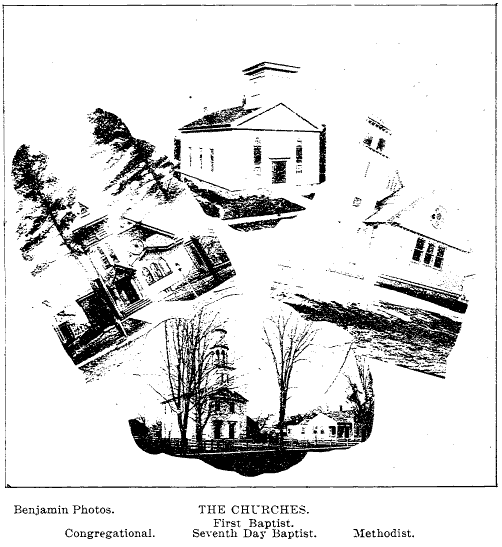 who were desirous to know more fully the polity of the Congregational Church. As a result, on August 6, 1896, the First Congregational church and society was organized and incorporated by Dr. Bull. Nineteen members united with the church, thirteen on confession and six by letter. The following trustees were elected: I. E. Smith, W. H. Hardie and W. J. Hodges. The new organization met for divine service in Russell's hall. The pulpit was supplied by Rev. D. W. Bull, Rev. Ethan Curtis, secretary New York State Home Mission society and Rev Lemuel Jones, state missionary, until November of the same year, when Rev. D. W. Bull was called to pastorate in connection with the Home Mission society. Meanwhile, a subscription had been started with the view of building a suitable church in which to worship. The result of this effort far exceeded the expectation of the committee in charge. A prominent lot on the south side of Cortland street was purchased. M. E. Tallett, H. P. Mitchell and E. Nash were elected the building committee, with B. S. Bryant treasurer. Plans were adopted, and the work on the church edifice begun early in the winter of 1896. The building committee pushed the work rapidly to completion. In the afternoon of July 21, 1897, the beautiful church, with its rich exterior, its elaborate furnishings, was dedicated. The dedicatory sermon was delivered by Rev. Wm E. Griffis, D. D., of Ithaca, N. Y. Rev. Edward Evans, of Camden, N. Y., preached in the evening. The church complete cost nearly $4,000.
who were desirous to know more fully the polity of the Congregational Church. As a result, on August 6, 1896, the First Congregational church and society was organized and incorporated by Dr. Bull. Nineteen members united with the church, thirteen on confession and six by letter. The following trustees were elected: I. E. Smith, W. H. Hardie and W. J. Hodges. The new organization met for divine service in Russell's hall. The pulpit was supplied by Rev. D. W. Bull, Rev. Ethan Curtis, secretary New York State Home Mission society and Rev Lemuel Jones, state missionary, until November of the same year, when Rev. D. W. Bull was called to pastorate in connection with the Home Mission society. Meanwhile, a subscription had been started with the view of building a suitable church in which to worship. The result of this effort far exceeded the expectation of the committee in charge. A prominent lot on the south side of Cortland street was purchased. M. E. Tallett, H. P. Mitchell and E. Nash were elected the building committee, with B. S. Bryant treasurer. Plans were adopted, and the work on the church edifice begun early in the winter of 1896. The building committee pushed the work rapidly to completion. In the afternoon of July 21, 1897, the beautiful church, with its rich exterior, its elaborate furnishings, was dedicated. The dedicatory sermon was delivered by Rev. Wm E. Griffis, D. D., of Ithaca, N. Y. Rev. Edward Evans, of Camden, N. Y., preached in the evening. The church complete cost nearly $4,000. 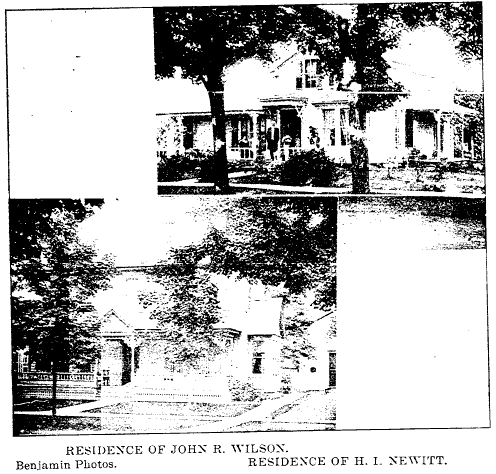 At the close of the dedicatory service, about $1,000 remained unprovided for. The Church Building society of the Congregational church gave $500. The balance was assured by the Ladies' Aid society. The church is now free of all encumbrance. The church, at present, is fostered by the Home Mission society. With its various organizations, it has steadily prospered. Fifty-one have united with the church since it was formed. Dr. Bull is still the missionary pastor. The Sunday-school has a membership of seventy-five. W. H. Hill is the efficient superintendent, Miss Blanche Beekman, secretary, Mrs. M. E. Tallett, treasurer.
At the close of the dedicatory service, about $1,000 remained unprovided for. The Church Building society of the Congregational church gave $500. The balance was assured by the Ladies' Aid society. The church is now free of all encumbrance. The church, at present, is fostered by the Home Mission society. With its various organizations, it has steadily prospered. Fifty-one have united with the church since it was formed. Dr. Bull is still the missionary pastor. The Sunday-school has a membership of seventy-five. W. H. Hill is the efficient superintendent, Miss Blanche Beekman, secretary, Mrs. M. E. Tallett, treasurer.
The pastor, David W. Bull, was born in London, Eng. When nine years of age, he was sent to the Higate boarding school. His thoughts were early inclined towards the profession of a medical missionary. With this end in view and to prepare himself for that work, he entered Morlay college, graduating from that institution in 1874. After his theological course, he took a special course in medicine and was made a licentiate in May 1878; was ordained in London, March 19, 1877. Soon after graduation, Dr. Bull came to the America, visiting the Eastern and Middle states. The result of this visit was the means of changing, somewhat, his purpose in life; he concluded to make his home in the New World. With the exception of one year spent in the practice of medicine he has held pastorates in Illinois and New York State. Since 1890 he has been a missionary pastor in the employ of the Congregational Home Missionary society. .
Village of Log Houses ---DeRuyter was a village of six log houses in 1805 and one store which was kept by a man named Gray.
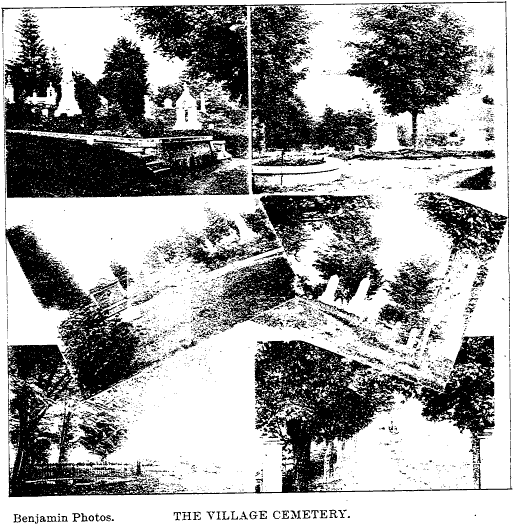 The DeRuyter Banking Co. was organized under that name---or rather re-organized as a banking institution---Jan. 1, 1899. It was established as private enterprise on Nov. 1, 1889, by F. S. Mitchell, with a capital of $5,000. At once it became apparent that such an institution was needed in the community, and on April 1, 1890, it was re-organized as The Individual Banking Co. with a capital of $10,000 comprising 100 shares. The bank has proved a pronounced financial success, having a loan and discount business of approximately $40,000 and paying big dividends. There has been but one change in the original shareholders, the death of Henry Hill (No.8), whose interest is now held by his widow, Josie E. Hill. The present stockholders are residents of DeRuyter, except Charles H. Maxson, who lives in Westerly, R. I., and A. R. Bryant, of Truxton. The officers and shareholders are as follows: (1) Pres. B. S. Bryant; (4) Vice Pres., Morell Tallett; (3) Cashier, F. S. Mitchell; (6) Chas. H. Maxson, (5) H. Benjamin, (2) H. P. Mitchell, (11) A. R. Bryant, Mrs. Josie Hill, (9) Henry Howes, (10) W. E. Burdick and (7) E. H. Lee. The last statement, made June 1, 1900 is as follows:
The DeRuyter Banking Co. was organized under that name---or rather re-organized as a banking institution---Jan. 1, 1899. It was established as private enterprise on Nov. 1, 1889, by F. S. Mitchell, with a capital of $5,000. At once it became apparent that such an institution was needed in the community, and on April 1, 1890, it was re-organized as The Individual Banking Co. with a capital of $10,000 comprising 100 shares. The bank has proved a pronounced financial success, having a loan and discount business of approximately $40,000 and paying big dividends. There has been but one change in the original shareholders, the death of Henry Hill (No.8), whose interest is now held by his widow, Josie E. Hill. The present stockholders are residents of DeRuyter, except Charles H. Maxson, who lives in Westerly, R. I., and A. R. Bryant, of Truxton. The officers and shareholders are as follows: (1) Pres. B. S. Bryant; (4) Vice Pres., Morell Tallett; (3) Cashier, F. S. Mitchell; (6) Chas. H. Maxson, (5) H. Benjamin, (2) H. P. Mitchell, (11) A. R. Bryant, Mrs. Josie Hill, (9) Henry Howes, (10) W. E. Burdick and (7) E. H. Lee. The last statement, made June 1, 1900 is as follows:
Resources:---Loans and discounts, $39,488.37; bonds and mortgages, $21,070.22; furniture and fixtures, $500.00; premium, $90.00; cash and due from banks, $47,109.10; total $108,257.69.
Liabilities:---Capital, $10,000.00; surplus $2,000.00; undivided profits, $3,311.27; due banks, $313.05; due depositors, $92,633.37; total $108,257.69.
First Day Baptist Church---The First Day Baptist church of DeRuyter had its beginning in meetings under the leadership of Elder Joel Butler, during the year 1798. It was formally recognized December 26, 1798, by a council called for the purpose. The first house of worship was erected on a piece of property owned by Eli Spear, which lay east of thr saw-mill pond, and was completed in 1818, a building 30x40 feet, one and one-half stories in height and without paint or steeple. Later in the years from 1839-1842, another house was built on the present site and was dedicated in June, 1842. 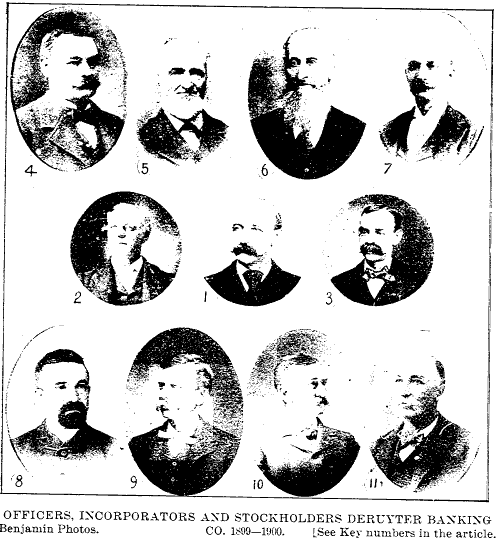 The building was remodeled and rededicated March, 1889, Rev. A. K. Fuller preaching the sermon. Seven have been licensed to preach and five have been ordained to the fuller work of the ministry:---Richard H. Benedict, July 10, 1816; Lewis T. Seaman in 1822; L. W. Webster in 1833; J. B. Pixley in 1841 and George B. Bradley in 1898. About fifty-four ministers have served the church as pastor, of whom we may mention the names Joel Butler, R. H. Benedict, J. B. Pixley, Thomas Fisher, L. L. Gage, L. B. Day, S. P. Way, W. C. Phillips, A. K. Fuller, F. M. Hungate, Judson Davis, S. S. Utter, G. D. Adams, F. H. Richardson, G. B. Bradley and H. T. Proctor. The present pastor is W. E. Darrow. Thirteen men have acted as deacons. There have been ten clerks including the present incumbent, A. P. Spicer. The church was represented in 1806 in a conference at New Woodstock incipient to the formation of the Madison Baptist association, which was formally organized in German (now Pitcher) August 31, 1808. On November 26, 1831, ten members of the church were dismissed by letter in order to form the Georgetown Baptist church. The centennial of the church was appropriately observed on December 26, 1899.
The building was remodeled and rededicated March, 1889, Rev. A. K. Fuller preaching the sermon. Seven have been licensed to preach and five have been ordained to the fuller work of the ministry:---Richard H. Benedict, July 10, 1816; Lewis T. Seaman in 1822; L. W. Webster in 1833; J. B. Pixley in 1841 and George B. Bradley in 1898. About fifty-four ministers have served the church as pastor, of whom we may mention the names Joel Butler, R. H. Benedict, J. B. Pixley, Thomas Fisher, L. L. Gage, L. B. Day, S. P. Way, W. C. Phillips, A. K. Fuller, F. M. Hungate, Judson Davis, S. S. Utter, G. D. Adams, F. H. Richardson, G. B. Bradley and H. T. Proctor. The present pastor is W. E. Darrow. Thirteen men have acted as deacons. There have been ten clerks including the present incumbent, A. P. Spicer. The church was represented in 1806 in a conference at New Woodstock incipient to the formation of the Madison Baptist association, which was formally organized in German (now Pitcher) August 31, 1808. On November 26, 1831, ten members of the church were dismissed by letter in order to form the Georgetown Baptist church. The centennial of the church was appropriately observed on December 26, 1899.
Rev. W. E. Darrow was born in New York City on September 2, 1864, and received his early education in one of the public schools of the city. In 1879 he united with the East Baptist church, a church in the lower part of the city and about two years after he began study preparatory to the work of the ministry. The necessity of earning a livelihood kept him from any systematic course of study until the fall of 1888, when he entered the Theological seminary at Hamilton and was graduated in 1892, the First Baptist church, Brooklyn, E. D., helping him to the attainment of this end. On the first of April preceding his graduation, he became pastor of the Fort Plain Baptist church and continued as such until October, 1894, when he left to take charge of the church at Mechanicville, where he remained until April, 1896. During his pastorate at Fort Plain, a new church edifice was erected and dedicated, and at Mechanicville, a divided church organization was brought into harmony. Conscious of lack in his preparation for the full work of the ministry and anxious to realize the hopes of earlier years for a regular collegiate training, he attended Cook academy from September, 1896, to his graduation, June, 1899, serving as pastor of the Reading Baptist church, which was about 8 miles distant, during his attendance at the school. In the summer of 1899, he removed to Hamilton for study in the college department of Colgate university, and since then he has supplied the DeRuyter Baptist church, coming on Saturdays and returning to Hamilton on Mondays. On June 16, 1892, Mr. Darrow was married to Miss Hattie Mills of Durhamville, of which union there are three children, two boys and a girl. He was ordained at Fort Plain, June 28, 1892.
Frank S. Mitchell, the druggist, and cashier of the DeRuyter Banking Co., is quite largely interested in the affairs of the village, being the owner of considerable valuable real estate and is also concerned in the business future of the village by reasons of his large business interests. Frank S. Mitchell was born in DeRuyter July 11, 1859, the son of Aaron and Mary Sears Mitchell. He was educated in the DeRuyter schools. When a mere boy he learned telegraphy and was later given the position of telegrapher at the DeRuyter station.
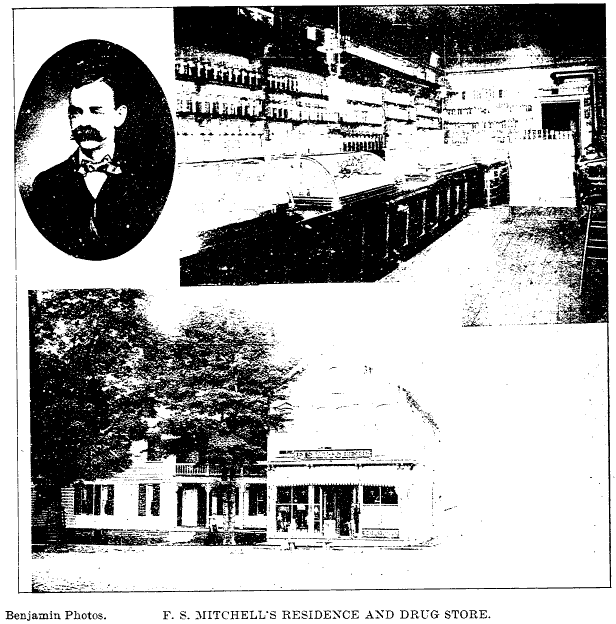
The Junior Endeavor, Seventh Day Baptist church, was organized Jan. 8, 1898, with the following officers: Pres., Lilla Murray; Vice Pres., Lillian Stillman; Sec., Lois Holmes; Treas., Cora Coon. The church is very fortunate in having a goodly number of boys and girls who are bright, active workers in the society. The social and floral committees have done very efficient work. The society gives yearly for benevolent purposes at home and abroad. This year the money for foreign work was sent to starving India. The present officers are: Pres., Leslie Swinney; Vice Pres., Melvin Coon; Sec., Daisy Miles; Treas., Raymond Burdick; Supt., Bertha Annas.
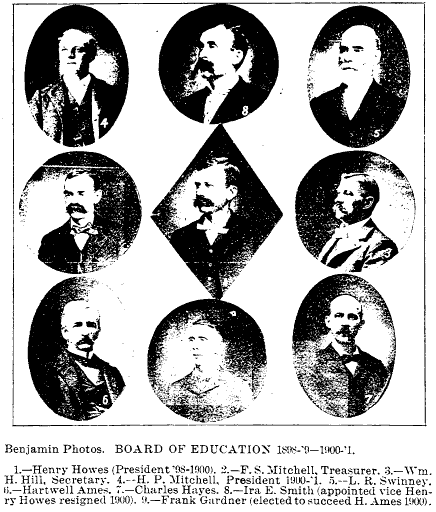
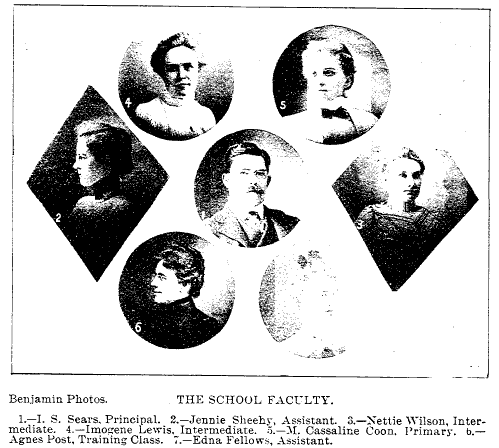
The DeRuyter Public School---The pioneers who first interested the people of this vicinity in educational work were Rev. Alexander Campbell, Deacon Henry Crandall and Dr. Ira Spencer. After several conferences these three men called a meeting of the citizens of DeRuyter. A committee was appointed to draft resolutions and plans to be presented at another meeting. Elder Campbell was chairman of this committee. At an adjourned meeting called by the chairman, Lebarion Goodwin, it was resolved that the citizens of DeRuyter and vicinity shall subscribe the sum of three thousand dollars, upon condition, that the Seventh Day Baptists erect a suitable building for a school in or near the village, which shall cost ten thousand dollars. At this meeting they organized a board of twelve trustees and elected Rev. Campbell chairman and general agent. He visited Rhode Island, Connecticut, New Jersey, Pennsylvania, Virginia and Ohio and raised the amount needed. Then, he, as general agent, purchased about one hundred acres of land of Dr. Hubbard Smith, the intention being at the time to institute an agricultural department in connection with the school. The original deed given by Dr. Hubbard Smith to Elder Campbell and Deacon Henry Crandall---as custodians---is still in my possession. Elder Campbell, Deacon Crandall and Lebarion Goodwin were appointed the building committee. They let the stone work by contract and the wood work by the day. Work was commenced in the spring of 1836. The stone were obtained from five different points, viz: The farm known as the Bly farm, now owned by Henry Howes, the James Nye farm occupied by the late David Wilcox, the farm known as the Benjamin I. Burdick farm, now owned by his heirs; the cap stones over the doors and windows from a quarry on the Joseph Fairbank farm, now owned by Mrs. Geo. F. Annas, and the front steps from Manlius, all cut and ready to set. The sand was taken from the Deacon Pardon Coon farm, five miles north of the village, now owned by Myron W. Coon. The timber and lumber were cut in the surrounding country and mostly sawed in the old Red mill. The house now occupied by Rev. L. M. Cottrell and Blanche Griffith was moved from the grounds and used as a boarding hall in connection with the school. The beautiful line of maple trees surrounding the school grounds were brought and set by contract, for eighteen cents apiece. In the spring of 1837, the building not being completed, a primary school was started with a Miss Robinson as teacher. The building was completed the following fall, at an expense of $32,000, this amount including the interior furnishings, library, chemical apparatus, furniture, etc. The academy was opened the same fall (1837) with Prof. Rollo as principal and Miss Bonney as preceptress, with several assistants. One hundred and forty students were registered the first term. The next year Prof. Solomon Carpenter and wife were installed as principal and preceptress, which positions they held for several years. Mr. Carpenter was a graduate of Brown university, Providence, R. I. Prof. Giles M. Langworthy, principal, and Miss Caroline Wilcox, preceptress, occupied positions one year succeeding Prof. Carpenter, after which Prof. Wood and Miss Severance were installed as heads of the school.
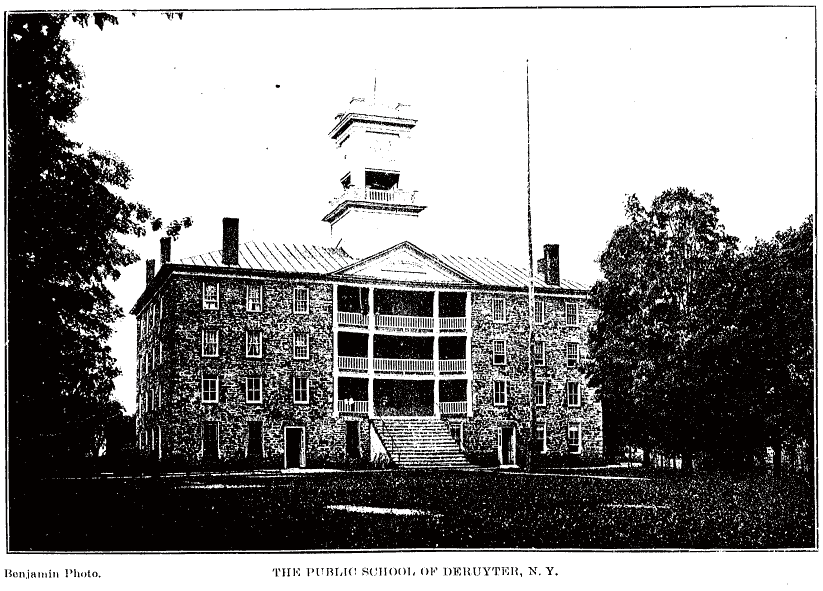
On March 24, 1874, at a meeting of the citizens of the two districts known as districts No. 1 and 11, it was resolved that the school district No.1 of the towns of DeRuyter and Cuyler and district No.11 of the town of DeRuyter be consolidated by the establishment of a Union Free school. At this meeting the following board of education were elected: J. B. Wells for one year, Gilbert Taber and B. G. Stillman for two years and Horace Benjamin and Joseph Crumb for three years, commencing the second Tuesday of October, 1874. On March 28, 1874, the board elected B. G. Stillman president, and J. B. Wells secretary, and purchased the present building and site for $2,535.00. Between the closing of DeRuyter institute as a school and the date of this purchase, Mr. Hollister---now living in Cortland---taught a select school. The first teachers were Miss E. Reynolds of Clockville, and Miss Sarah E. White of Sheds Corners, at a salary of $10 per week each. Sept. 7, 1874, Mr. A. M. Wright of Cortland was secured as principal at a salary of $180. At the end of the winter term, 1875, Miss Reynolds became preceptress and Miss White assistant. Oct. 12, 1875, Miss S. Marie Stillman was hired as an assistant. At the annual school meeting, October, 1875, Dr. Silas S. Clark was elected to succeed J. B. Wells on the board and E. B. Parsons was elected treasurer and J. W. Annas collector. Oct. 19, 1875, J. H. Crumb was elected president and Dr. Clark secretary. Miss Mary W. Kiem was hired to teach the primary department commencing Jan. 3, 1876. Jan. 5, 1876, a resolution was passed that academical department be established. March 10, 1876, Rev. Joshua Clark was appointed a member of the board in place of J. H. Crumb, resigned. Elder Clark was elected president March 11, 1876. E. B. Woodworth was next hired as principal and S. Marie Stillman to teach the primary department. At this meeting E. B. Parsons resigned as treasurer of school and at the next meeting G. F. Annas was elected in his place. At the annual school meeting, Oct. 10, 1876, Elder Clark was elected president and E. B. Parsons and George Lewis succeeded Gilbert Taber and B. G. Stillman. Nov. 23, 1876, Miss Marion Mitchell was hired as teacher in the intermediate department. April 19, 1877, Miss S. Marie Stillman succeeded Mr. Woodworth as head of the school with Miss Mitchell assistant. June 27, 1877, Prof. E. C. Wheeler of Cincinnatus was hired as principal. 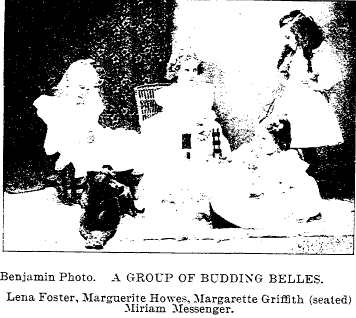 Jan. 10, 1878, Miss Lizzie Ager became an assistant teacher. At the annual school meeting Oct. 14, 1879, W. E. Burdick was elected trustee for three years in place of E. B. Parsons. At a meeting Oct. 12, 1880, George Annas was elected trustee in place of Horace Benjamin. Oct. 25, 1880, Miss Grace Griswold was hired as the fourth teacher. Sept. 21, 1881, Miss Ettie Mitchell took her place. Oct. 17, 1882, George F. Annas was elected president and W. E. Burdick secretary. Oct. 23, 1882, Miss Mary Hanchett was hired as one of the teachers. In the fall of 1883, E. W. Dow of Hamilton became principal, Miss Mary E. Tilton, assistant. Oct. 9, 1883, R. P. York was elected trustee in place of George F. Annas. At the following board meeting George Lewis was elected president and W. G. Weed, secretary. Aug. 30, 1887, C. H. Maxson was elected a member of the board. In the fall of 1885 Mr. Lindsay became principal, Mr. Lansing and Miss Link assistants. The following fall Prof. E. A. Winchell was hired as principal, Miss Myrtie Andrews assistant, Miss Hattie Graves in the intermediate and Miss Jessie Link in the primary department. August, 1888, George S. Mason and Dr. E. N. Coon were chosen trustees in place of Geo. Lewis and W. E. Burdick. At the following board meeting, C. H. Maxson was elected president and George S. Mason, secretary. Aug. 6, 1887, Rev. L. R. Swinney was elected trustee in place of W. G. Weed. Aug. 3, 1891, H. K. Nash was elected in place of Dr. E. N. Coon, and in 1892, H. P. Mitchell in the place of L. R. Swinney. Prof. Hermon C. Woodworth was principal during the school year of 1892-'93, Miss Sherman, Miss Graves, Miss Maltby and Miss Thompson, assistants. The instructors for the school year 1893-'94 were: Prof. Lang, principal; Miss Luttendon, assistant; Miss White, intermediate; Miss Graves, primary. Instructors 1894-'5---Irving S. Sears, principal; Flora M. Sears, assistant principal; Mary L. White, Junior department; Jessie L. Maltby, intermediate; Belle A. Stillman, primary. Board of education---Charles H. Maxson, president; George S. Mason, secretary; Rev. L. R. Swinney, Horace Benjamin and Henry K. Nash. Instructors 1896-'97---Irving S. Sears, principal; Grace L. Rugg, assistant principal; Agnes C. Post, training class; Mary L. White, junior department; Jessie L. Maltby, intermediate; M. Cassaline Coon, primary.
Jan. 10, 1878, Miss Lizzie Ager became an assistant teacher. At the annual school meeting Oct. 14, 1879, W. E. Burdick was elected trustee for three years in place of E. B. Parsons. At a meeting Oct. 12, 1880, George Annas was elected trustee in place of Horace Benjamin. Oct. 25, 1880, Miss Grace Griswold was hired as the fourth teacher. Sept. 21, 1881, Miss Ettie Mitchell took her place. Oct. 17, 1882, George F. Annas was elected president and W. E. Burdick secretary. Oct. 23, 1882, Miss Mary Hanchett was hired as one of the teachers. In the fall of 1883, E. W. Dow of Hamilton became principal, Miss Mary E. Tilton, assistant. Oct. 9, 1883, R. P. York was elected trustee in place of George F. Annas. At the following board meeting George Lewis was elected president and W. G. Weed, secretary. Aug. 30, 1887, C. H. Maxson was elected a member of the board. In the fall of 1885 Mr. Lindsay became principal, Mr. Lansing and Miss Link assistants. The following fall Prof. E. A. Winchell was hired as principal, Miss Myrtie Andrews assistant, Miss Hattie Graves in the intermediate and Miss Jessie Link in the primary department. August, 1888, George S. Mason and Dr. E. N. Coon were chosen trustees in place of Geo. Lewis and W. E. Burdick. At the following board meeting, C. H. Maxson was elected president and George S. Mason, secretary. Aug. 6, 1887, Rev. L. R. Swinney was elected trustee in place of W. G. Weed. Aug. 3, 1891, H. K. Nash was elected in place of Dr. E. N. Coon, and in 1892, H. P. Mitchell in the place of L. R. Swinney. Prof. Hermon C. Woodworth was principal during the school year of 1892-'93, Miss Sherman, Miss Graves, Miss Maltby and Miss Thompson, assistants. The instructors for the school year 1893-'94 were: Prof. Lang, principal; Miss Luttendon, assistant; Miss White, intermediate; Miss Graves, primary. Instructors 1894-'5---Irving S. Sears, principal; Flora M. Sears, assistant principal; Mary L. White, Junior department; Jessie L. Maltby, intermediate; Belle A. Stillman, primary. Board of education---Charles H. Maxson, president; George S. Mason, secretary; Rev. L. R. Swinney, Horace Benjamin and Henry K. Nash. Instructors 1896-'97---Irving S. Sears, principal; Grace L. Rugg, assistant principal; Agnes C. Post, training class; Mary L. White, junior department; Jessie L. Maltby, intermediate; M. Cassaline Coon, primary. 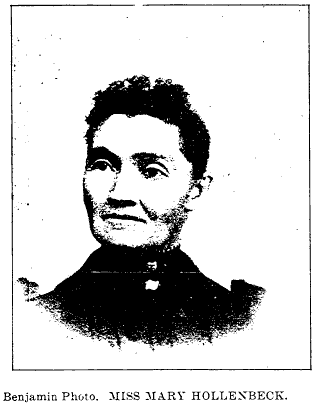 The DeRuyter Union school and academy was placed on the list of permanent training class schools Sept. 16, 1895, and maintained a class of sixteen members during that year. In 1897-'98, Miss Jennie Sheehy taught in the place of Miss Rugg, and Miss Janette Wilson in the place of Miss Maltby. In the board of education Rev. L. R. Swinney became president while Henry Howes and Charles Hayes were elected in the place of Charles H. Maxson and Horace Benjamin. June 29, 1897, the board were granted a union high school charter. In 1898-'9, the board of education was Henry Howes, president; William H. Hill, secretary; Rev. L. R. Swinney, Byron S. Bryant and Charles Hayes. In the junior department, Miss Helen Robinson was the teacher that year. In the spring of 1900 Hartwell Ames was appointed on the board to succeed B. S. Bryant, retiring. Miss Imogene Lewis began teaching in the fall term in the place of Miss Robinson. At the annual school meeting, 1900, Frank Gardner was elected trustee to succeed Hartwell Ames and Ira E. Smith was appointed in the place of Henry Howes, who resigned. H. P. Mitchell was chosen president of the board for the ensuing year, William Hill secretary, and Frank Mitchell treasurer.
The DeRuyter Union school and academy was placed on the list of permanent training class schools Sept. 16, 1895, and maintained a class of sixteen members during that year. In 1897-'98, Miss Jennie Sheehy taught in the place of Miss Rugg, and Miss Janette Wilson in the place of Miss Maltby. In the board of education Rev. L. R. Swinney became president while Henry Howes and Charles Hayes were elected in the place of Charles H. Maxson and Horace Benjamin. June 29, 1897, the board were granted a union high school charter. In 1898-'9, the board of education was Henry Howes, president; William H. Hill, secretary; Rev. L. R. Swinney, Byron S. Bryant and Charles Hayes. In the junior department, Miss Helen Robinson was the teacher that year. In the spring of 1900 Hartwell Ames was appointed on the board to succeed B. S. Bryant, retiring. Miss Imogene Lewis began teaching in the fall term in the place of Miss Robinson. At the annual school meeting, 1900, Frank Gardner was elected trustee to succeed Hartwell Ames and Ira E. Smith was appointed in the place of Henry Howes, who resigned. H. P. Mitchell was chosen president of the board for the ensuing year, William Hill secretary, and Frank Mitchell treasurer.
H. JEROME CRANDALL
Miss Mary Hollenbeck entered the store of J. H. Delamater as saleslady in 1865. Being the first lady to sell goods in the village, it created not a little talk, some criticising and others defending her. For twenty-two years she has served in this capacity. All of this time, with the exception of one year in Syracuse for T. C. Dillay, and three in Buchanan, Mich., has been spent in this beautiful village. Her success as a saleslady, and the progressive spirit she has shown in business, justified her course. Her childhood home was Cuyler, Cortland county. Being one of a large family, she was early forced to leave school and has made her way in life, winning many friends and a large number of acquaintances who would sincerely regret her retirement from mercantile life.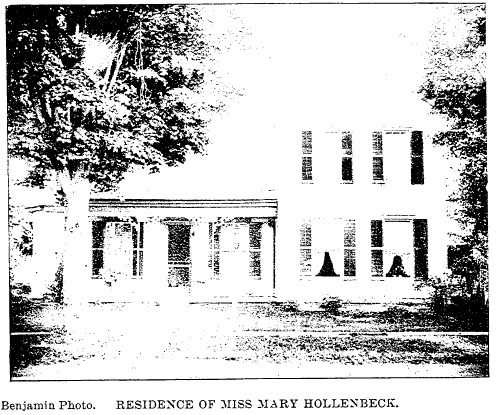 The M. E. Church---The history of DeRuyter Methodism begins with the year 1830, when meetings were held from time to time in the old DeRuyter chapel, which is now used as a hay barn [see view, page 3] two miles north of the village. As early as 1837, DeRuyter chapel was made one of the regular appointments of the Truxton circuit and was served at that time by Rev. Zetto Barnes, with Wesley Fox as local preacher. The Rev. Zachariah Paddock was then presiding elder of this district. Prominent among those who helped to establish Methodism in DeRuyter were the Rev. L. J. Wheelock who still resides in the village, being upwards of 88 years of age, John S. Morse, Morris House, Isaac Foster, Jason Burdick, Abner Brown and John Culver. In 1838, the Methodists began to hold meetings in DeRuyter village at the different homes of the members of the church. A little later these meetings were held in the old Presbyterian church, which stood on the site now occupied by the Methodist church, and DeRuyter chapel was abandoned. In 1860, on the 27th of December, the Methodists dedicated a church situated on the north corner of Cortland and Division streets, and now occupied by Benjamin's photograph gallery, Burdick's law office and Newitt's store. The present site was secured from the Presbyterian church and the church home now occupied by the Methodists was built, largely through the perseverance and energy of the Rev. James Stanton. In 1895 the former home of Colonel York was purchased by the church and fitted up for a parsonage. In 1896, through the efforts of Rev. A. E. Hall, a Methodist church was built in Quaker Basin, near the former site of the old Quaker church and has since been connected with DeRuyter Methodism. At the present time the entire property of the church is practically free from indebtedness and the church is stronger in numbers and in a better condition generally than ever before. Among the faithful members of the past who have helped make the present conditions possible were Trowbridge Allen, Joseph Lyon, George Newitt, George Hayes and many others who with these have passed on before.
The M. E. Church---The history of DeRuyter Methodism begins with the year 1830, when meetings were held from time to time in the old DeRuyter chapel, which is now used as a hay barn [see view, page 3] two miles north of the village. As early as 1837, DeRuyter chapel was made one of the regular appointments of the Truxton circuit and was served at that time by Rev. Zetto Barnes, with Wesley Fox as local preacher. The Rev. Zachariah Paddock was then presiding elder of this district. Prominent among those who helped to establish Methodism in DeRuyter were the Rev. L. J. Wheelock who still resides in the village, being upwards of 88 years of age, John S. Morse, Morris House, Isaac Foster, Jason Burdick, Abner Brown and John Culver. In 1838, the Methodists began to hold meetings in DeRuyter village at the different homes of the members of the church. A little later these meetings were held in the old Presbyterian church, which stood on the site now occupied by the Methodist church, and DeRuyter chapel was abandoned. In 1860, on the 27th of December, the Methodists dedicated a church situated on the north corner of Cortland and Division streets, and now occupied by Benjamin's photograph gallery, Burdick's law office and Newitt's store. The present site was secured from the Presbyterian church and the church home now occupied by the Methodists was built, largely through the perseverance and energy of the Rev. James Stanton. In 1895 the former home of Colonel York was purchased by the church and fitted up for a parsonage. In 1896, through the efforts of Rev. A. E. Hall, a Methodist church was built in Quaker Basin, near the former site of the old Quaker church and has since been connected with DeRuyter Methodism. At the present time the entire property of the church is practically free from indebtedness and the church is stronger in numbers and in a better condition generally than ever before. Among the faithful members of the past who have helped make the present conditions possible were Trowbridge Allen, Joseph Lyon, George Newitt, George Hayes and many others who with these have passed on before. 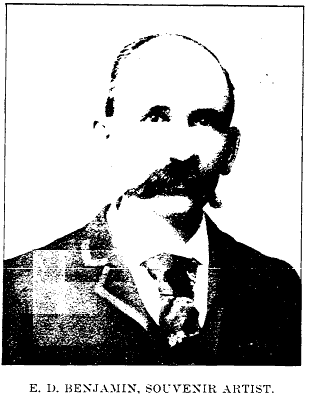 Among the pastors who have served the church since 1837 we give the following names: Zetto Barnes, S. B. Yarrington, L. H. Reddington, D. Fancher, A. Johnson, E. Hoag, I. D. Warren, John Crawford, F. C. Winslow, Wesley Fox, I. Crop, E. House, George Boughton, V. L. Torry, A. C. Bowdish, R. H. Clark, William Adams, James Stanton, Henry Meeker, H. W. Williams, O. A. Retan, Charles Haynes, Frank Hamilton, A. E. Hall, G. W. Rosenberry. The history of DeRuyter Methodism would not be complete without the history of its local preachers, first and foremost of which stands L. J. Wheelock, who came to DeRuyter in 1836 and was licensed to preach in 1838. Since that time he has been a part, and a strong factor in thr Methodism of DeRuyter.
Among the pastors who have served the church since 1837 we give the following names: Zetto Barnes, S. B. Yarrington, L. H. Reddington, D. Fancher, A. Johnson, E. Hoag, I. D. Warren, John Crawford, F. C. Winslow, Wesley Fox, I. Crop, E. House, George Boughton, V. L. Torry, A. C. Bowdish, R. H. Clark, William Adams, James Stanton, Henry Meeker, H. W. Williams, O. A. Retan, Charles Haynes, Frank Hamilton, A. E. Hall, G. W. Rosenberry. The history of DeRuyter Methodism would not be complete without the history of its local preachers, first and foremost of which stands L. J. Wheelock, who came to DeRuyter in 1836 and was licensed to preach in 1838. Since that time he has been a part, and a strong factor in thr Methodism of DeRuyter.
Rev. Geo. W. Rosenberry, A. M., pastor of the Methodist Episcopal church of DeRuyter since October, 1897, was born in Mifflin county, Pa., in 1869. He spent the early years of his life on his father's farm and later taught in some of the district schools. He then prepared for college at Dickinson seminary, Williamsport, Pa., and was graduated from that school with the highest honors of his class. In 1896 he finished the classical course in Syracuse university, being elected to membership in Phi Beta Kappa and the key of that noted society he now wears. He is also a member of the Greek letter college fraternity, Delta Upsilon. In 1896 he was married to Esther Linter of Syracuse, N. Y. His first appointment after completing his college course was DeRuyter, N. Y., where he still resides.
E. DeForest Benjamin, who made the views and pictures for this work, demonstrated his artistic skill and excellent taste in a manner which proves that he ranks first among photographers. Painstaking and conscientious he counts results as of more importance than anything else, and invariably secures the best work whatever time or expense may be required. Ezra Benjamin, his father, was a farmer in Cuyler, his native town, and it was there that Mr. Benjamin was born, June 17, 1851. He was educated in the district schools and the DeRuyter institute, and in 1881 entered the gallery of I. Page at Cortland, where he learned the profession. In December, 1883, he opened a gallery in the building in the rear of the Merchant block, on Lincklaen Street, and in 1886 moved to his present quarters in the Jones block. On Dec. 10, 1872, he married Emogene, the daughter of Simeon Rider. His facilities are all that is necessary for every line of the work of an artist and his business is quite large.
Surrogates---[Merged with County Judge in 1847]: T. H. Hubbard, Hamilton, app. March 26, 1806; Dr. Asa B. Sizer, Madison, app. Feb. 26, 1816; John B. Stower, Hamilton, Feb. 19, 1821; Otis P. Granger, Morrisville, April 13, 1827; James B. Eldridge, Hamilton, Feb. 18, 1840; James W. Nye, Hamilton, February, 1844.
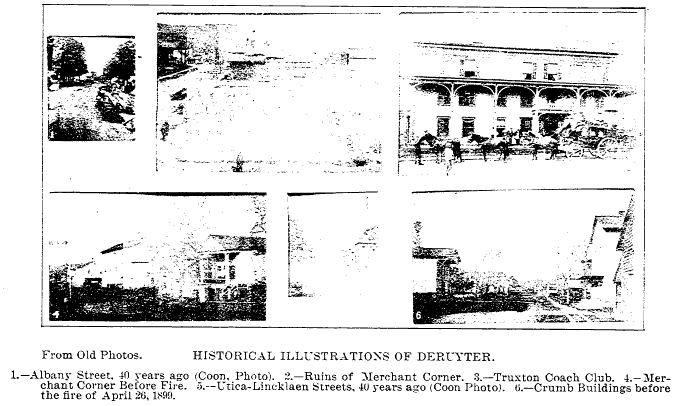
Adelbert W. Francis came to DeRuyter from Preble, in 1883, and worked for H. E. Hill in the village for three years. In 1887 he started the feed business at the railroad station and continued the same until March 6, 1899, at which time he sold out to E.M. Stanton and retired from actual business pursuit. At the time a village water supply was the mooted question, Mr. Francis took an active part in behalf of the proposition. He was made president of the first water board which it was found necessary to create in order to carry the question after it had been lost on a tie vote, and he not only worked hard for the success of the scheme, but as a member of the board for several years and its president it was largely by his efforts that the details were carried out. He was a member of the Republican county committee a number of years, was always ready to put his shoulder to the wheel on every public proposition. In local Masonic circles he is prominent, being a member of the DeRuyter lodge, F. & A. M., and is a member of A. O. U. W. and W. E. Hunt post, 352, G. A. R. He was born in Vernon, Oneida county, N. Y., Sept. 12, 1840. In 1851 his parents moved to Georgetown, where his father bought the village grist and saw mill, which he ran for about eighteen years. Mr. James Francis was a farmer in the town of Oneida for a great many years. When the widely known Oneida community decided to locate in that section, Mr. Francis sold them the farm. Their main buildings stand on the site of the old Francis homestead. At the time the abolitionists under the leadership of Gerritt Smith started the "underground road" for helping the slaves of the South to freedom, Mr. James Francis' home was made a station and he devoted himself to assisting the negroes in their flight. His son, A. W., enlisted in the 117th New York Infantry in August , 1862, and served until the regiment was mustered out in June, 1865. Upon his return home he entered the milling business in company with his father, but in 1871 formed a co-partnership with Elisha Green and the two under the firm name of Francis & Green conducted the stone grist mills at Lebanon. In 1877 Mr. Francis engaged in the same business at Truxton and in 1881 and '82 was a member of the firm of Crofoot & Francis, millers at Preble. His mother died in 1871 and his father in 1874. On Jan. 1, 1867, Mr. Francis married Sarah M., the daughter of William and Charlotte (Way) Pierce of Otselic. Mr. Francis has one sister, Mrs. Adelia Stewart of Durhamville. His father was the son of Job Francis, an officer in the Revolutionary war.
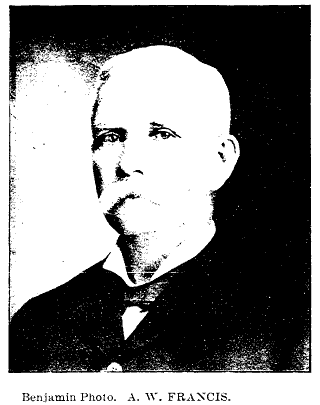
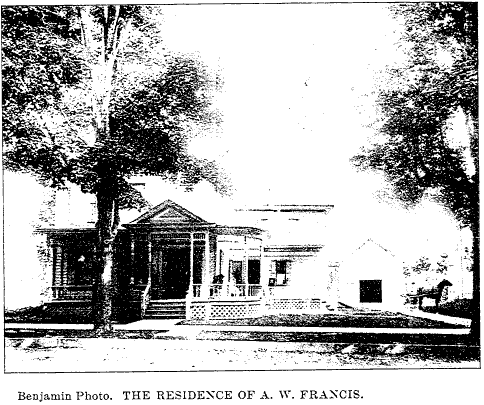
The W. C. T. U.---In February, 1888, after a series of temperance meetings, held in DeRuyter by Joe English, the outcome was the organization of the Reform club and Woman's Christian Temperance union, the first only remaining in existence about four years. But during that time the two societies jointly sustained a reading room. One of the most important departments of the W. C. T. U., for about five years, was conducting the Juvenile work under the organization of Loyal Temperance Legion, and for a number of years the constant holding of monthly gospel temperance services, which have always been largely attended. The following ladies have served as presidents: Mrs. S. W. Fiske, Mrs. E. M. Wilcox, Mrs. L. R. Swinney and Mrs. E. A. Warner. The officers for the present year: Mrs. Bert Hills, Pres.; Mrs. S. W. Fiske, Vice Pres.; Mrs. L. R. Swinney, Cor. Sec.; Mrs. E. A. Warner, Rec. Sec.; Mrs. Geo. H. Hayes, Treas. The regular meetings are held Wednesday afternoons, semi-monthly.
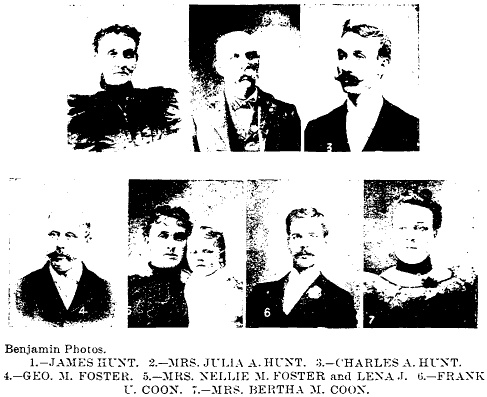 James Hunt, in the spring of 1867, bought the Mathew Wells farm and for twenty-three years it has been the home of himself and wife, where their children were born and where year after year the family have improved and cultivated it. The farm lies on the Shed's road, two and a half miles northeast of DeRuyter, the buildings standing on a sitely knoll where they overlook the whole property and have a perfect drainage. Wells and streams provide an abundance of pure water. It is an ideal dairy farm upon which Mr. Hunt keeps a herd of from twenty-five to thirty dairy cows, including very fine young cattle. Orchards and shade trees, berries and garden truck thrive abundantly. Mr. Hunt, the son of William Hunt, a prominent and active resident of the town of DeRuyter for a great many years, was born at Quaker Basin, Sept. 2, 1842. Leaving the farm when nineteen years old he went to Wisconsin and enlisted for three months in the Fourth Wisconsin Infantry, at the expiration of which time he received an honorable discharge and returned east to re-enlist, Aug. 5, 1863, in the 15th New York Cavalry, in which he served to the close of the war accompanying his regiment through the campaigns of the Army of the Potomac and receiving a second honorable discharge June 28, 1865. Mr. Hunt is a prominent Mason, Odd Fellow and member of the G. A. R. On November 22, 1865, he married Julia A. Gager of DeRuyter. She was born in Binghamton Oct. 6, 1843. Her father, Abram Gager, is now a resident of that city. After farming in Georgetown one year Mr. and Mrs. Hunt settled in their present home. Three children were born to them, Nellie M., Feb. 16, 1870, Bertha M., March 27, 1873 and Charles A., Aug. 2, 1877. During recent years the active part of the farm duties has devolved upon the latter which has greatly relieved his father. Nellie was married Sept. 26, 1894, to George M. Foster, the son of John and Jane Foster of Little York. Mr. Foster was born in Homer Aug. 17, 1857, and came to DeRuyter in 1890 where for five years he engaged in the meat business with R. L. Miller.
James Hunt, in the spring of 1867, bought the Mathew Wells farm and for twenty-three years it has been the home of himself and wife, where their children were born and where year after year the family have improved and cultivated it. The farm lies on the Shed's road, two and a half miles northeast of DeRuyter, the buildings standing on a sitely knoll where they overlook the whole property and have a perfect drainage. Wells and streams provide an abundance of pure water. It is an ideal dairy farm upon which Mr. Hunt keeps a herd of from twenty-five to thirty dairy cows, including very fine young cattle. Orchards and shade trees, berries and garden truck thrive abundantly. Mr. Hunt, the son of William Hunt, a prominent and active resident of the town of DeRuyter for a great many years, was born at Quaker Basin, Sept. 2, 1842. Leaving the farm when nineteen years old he went to Wisconsin and enlisted for three months in the Fourth Wisconsin Infantry, at the expiration of which time he received an honorable discharge and returned east to re-enlist, Aug. 5, 1863, in the 15th New York Cavalry, in which he served to the close of the war accompanying his regiment through the campaigns of the Army of the Potomac and receiving a second honorable discharge June 28, 1865. Mr. Hunt is a prominent Mason, Odd Fellow and member of the G. A. R. On November 22, 1865, he married Julia A. Gager of DeRuyter. She was born in Binghamton Oct. 6, 1843. Her father, Abram Gager, is now a resident of that city. After farming in Georgetown one year Mr. and Mrs. Hunt settled in their present home. Three children were born to them, Nellie M., Feb. 16, 1870, Bertha M., March 27, 1873 and Charles A., Aug. 2, 1877. During recent years the active part of the farm duties has devolved upon the latter which has greatly relieved his father. Nellie was married Sept. 26, 1894, to George M. Foster, the son of John and Jane Foster of Little York. Mr. Foster was born in Homer Aug. 17, 1857, and came to DeRuyter in 1890 where for five years he engaged in the meat business with R. L. Miller.
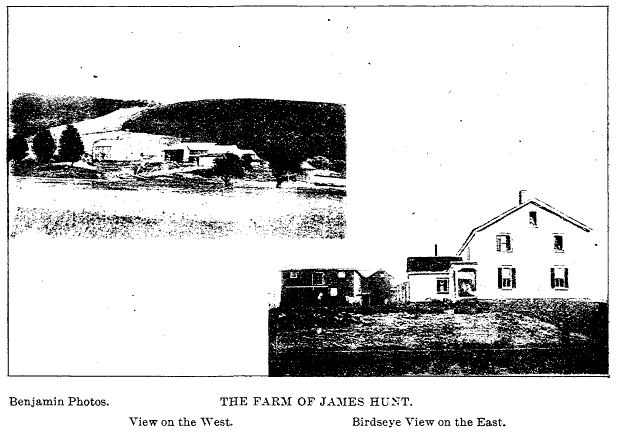
The March following his marriage Mr. Foster bought out his partner and continued the business alone to the time of his death which occurred after an illness of two weeks. Lena J., their only child, was born Feb. 1, 1896. Mr. Foster's death was a loss to the community, where his prominence in the Masons and Odd Fellows gave him a strong hold on a large circle of friends. He was treasurer of thr DeRuyter Lodge, F. & A. M., when he died. Bertha M. Hunt was married to Frank U., the son of Dr. E. N. Coon of DeRuyter Oct. 6, 1897, and they have a pleasant residence on Cortland Street. On Oct. 26, 1872, he was born in DeRuyter, where he attended school. 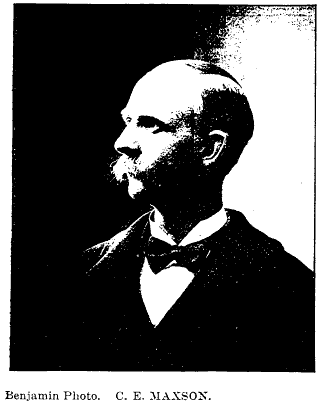 At sixteen years of age he began as a moulder in Cortland and worked at that trade four years, returning to DeRuyter in 1893 and working for Miller & Foster in the meat market one year and for George Foster in the same business three years. In the fall of 1897 he started in the meat business at Marathon and in April, 1899, formed a co-partnership with Virgil at DeRuyter.
At sixteen years of age he began as a moulder in Cortland and worked at that trade four years, returning to DeRuyter in 1893 and working for Miller & Foster in the meat market one year and for George Foster in the same business three years. In the fall of 1897 he started in the meat business at Marathon and in April, 1899, formed a co-partnership with Virgil at DeRuyter.
DeRuyter Grange, No. 651, P. of H., was organized at the schoolhouse at Quaker Basin, March 14, 1890, by State Organizer J. B. Whiting, with twenty-two charter members. On April 10 a home was established in the Old Friends' meeting house, where it remained until the house was removed in June. Temporary quarters were taken up in the old Shepard ballroom until Oct. 9, when it moved to its present home in the Russell block. Many of the best farmers of the community have taken an active interest in its work. On Dec. 21, 1892, the Grange brought the first farmers' institute to DeRuyter, and have maintained them each year since, not only furnishing means, but supplying quite an array of local talent. 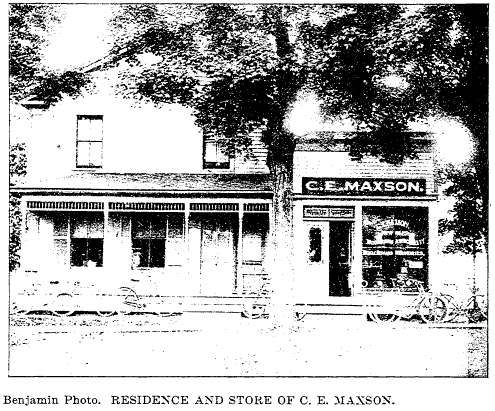 That these institutes have been profitable, can be best seen by a visit to some of the up-to-date rural homes. The Grange is at present under the management of W. M., Howard Muncy. The present secretary, B. E. Wood, has held that office since its organization in 1890. The following is a list of the first officers elected: A. D. Warren, W. M.; E. S. Newitt, O.; H. I. Newitt, L.; F. Connell, S.; Mrs. S. W. Cone, Chap.; B. E. Wood, Sec.; F. Maxson, Treas.; D. C. Wood, A. S.; F. Warren, G. K.; Mrs. F. Connell, L. A. S.; Mrs. D. C. Wood, Pom.; Mrs. B. E. Wood, Ceres; Mrs. F. Warren, Flora.
That these institutes have been profitable, can be best seen by a visit to some of the up-to-date rural homes. The Grange is at present under the management of W. M., Howard Muncy. The present secretary, B. E. Wood, has held that office since its organization in 1890. The following is a list of the first officers elected: A. D. Warren, W. M.; E. S. Newitt, O.; H. I. Newitt, L.; F. Connell, S.; Mrs. S. W. Cone, Chap.; B. E. Wood, Sec.; F. Maxson, Treas.; D. C. Wood, A. S.; F. Warren, G. K.; Mrs. F. Connell, L. A. S.; Mrs. D. C. Wood, Pom.; Mrs. B. E. Wood, Ceres; Mrs. F. Warren, Flora.
Charles E. Maxson came to DeRuyter eight years ago and bought the old school house on Cortland Street which had previously been converted into a residence. He remodeled and renovated the house, raising the roof and adding a porch so that it is now one of the most convenient and desirable of dwellings. On the west side he constructed an addition which he occupies as a store. He at once opened a jewelry store equipping it with the best lines as well as everything in the way of ammunition and camera supplies. In the rear is the workshop in which he carries on bicycle repairing and manufacturing of all kinds, keeping a man especially for that work. It is the only sportsmen's and bicycle headquarters in DeRuyter. Mr. Maxson was born in Richburg, Alleghany county, Dec. 26, 1868. His parents moved to Kansas when he was quite young and he spent his boyhood days in that state, returning to New York state when twelve years of age. Subsequently he spent six years in the oil regions where he had charge of a lease and he came here directly from the oil country. On Jan. 31, 1894, he married Nellie Taylor of DeRuyter, who died May 21, 1896. On March 21, 1897, he married Rose Crumb of DeRuyter.
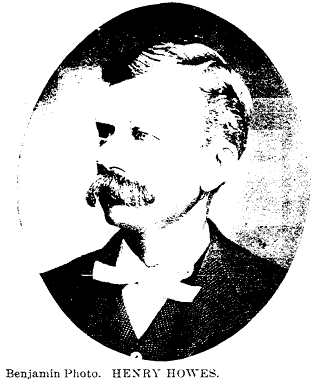 Henry Howes, for two years president of the DeRuyter board of education but recently resigned, and a large dealer in wool and live stock, is very largely known among state politicians as one of the most active of Cortland county Republicans. Although his home is in the town of Cuyler, Cortland county, it is adjoining the Madison county line. He is located on one of the pleasantest farms in Cortland county, comprising fifty-eight acres, once known as the Joseph Lyon place. It was there he located in March, 1895, and subsequently increased the property limits by the purchase of 100 acres of the Spencer farm across the road. In Nov. 1899, fire swept away his barns and during the following year he completed a new structure 34 x 60 with a half basement for stables and wagon house on the main floor and the second story for wool and hay. It is a large modern building with accommodations for several cattle and horses and storage room for 50,000 lbs. of wool, besides room for considerable hay, grain and harnesses. Mr. Howes' business in wool averages as high as $60,000 a year. Besides he is a natural speculator in real estate, cattle, horses, etc. During the year he employs a dozen or more wool buyers who gather in the product for miles around from several adjacent counties. In farm ventures he has usually been successful, engaging and holding agricultural property, improving it and selling it. Besides his home property he owns a very excellent farm of 272 acres in the town of Cuyler on the road from Cuyler village to Lincklaen, where he lived from 1882 to 1895, when he took up his present residence. The dairy herd shown in the accompanying engraving is on that place. It is in the corner of Chenango, Cortland and Madison counties, lies conveniently near to three villages and is well watered. About 1886, Mr. Howes began speculating in cattle and in 1892 took up handling wool, in the course of which he gained a wide circle of acquaintances with all of whom his fair and open dealings have made him very popular in Onondaga, Chenango, Madison and Cortland counties.
Henry Howes, for two years president of the DeRuyter board of education but recently resigned, and a large dealer in wool and live stock, is very largely known among state politicians as one of the most active of Cortland county Republicans. Although his home is in the town of Cuyler, Cortland county, it is adjoining the Madison county line. He is located on one of the pleasantest farms in Cortland county, comprising fifty-eight acres, once known as the Joseph Lyon place. It was there he located in March, 1895, and subsequently increased the property limits by the purchase of 100 acres of the Spencer farm across the road. In Nov. 1899, fire swept away his barns and during the following year he completed a new structure 34 x 60 with a half basement for stables and wagon house on the main floor and the second story for wool and hay. It is a large modern building with accommodations for several cattle and horses and storage room for 50,000 lbs. of wool, besides room for considerable hay, grain and harnesses. Mr. Howes' business in wool averages as high as $60,000 a year. Besides he is a natural speculator in real estate, cattle, horses, etc. During the year he employs a dozen or more wool buyers who gather in the product for miles around from several adjacent counties. In farm ventures he has usually been successful, engaging and holding agricultural property, improving it and selling it. Besides his home property he owns a very excellent farm of 272 acres in the town of Cuyler on the road from Cuyler village to Lincklaen, where he lived from 1882 to 1895, when he took up his present residence. The dairy herd shown in the accompanying engraving is on that place. It is in the corner of Chenango, Cortland and Madison counties, lies conveniently near to three villages and is well watered. About 1886, Mr. Howes began speculating in cattle and in 1892 took up handling wool, in the course of which he gained a wide circle of acquaintances with all of whom his fair and open dealings have made him very popular in Onondaga, Chenango, Madison and Cortland counties. 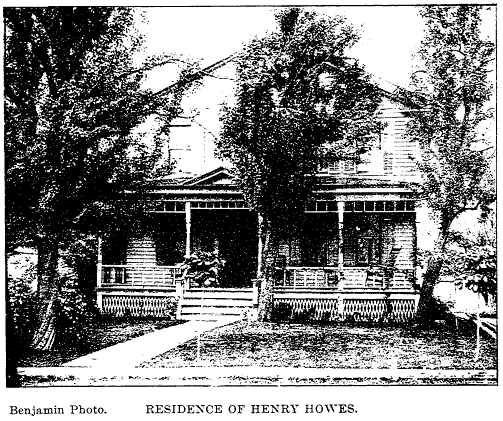 As a resident of the latter he has been prominently identified with the success of his party. During the Morton campaign he was chairman of the county committee and during the years 1890, '91 and '92 represented Cuyler on the board of supervisors. In his home village of DeRuyter across the county line he is among the first to agitate for public improvement and is considered a resident in effect if not fact. His interest in school matters led to his selection as one of the village school board. In DeRuyter he gets his mail, purchases all his supplies and ships extensively of the products he buys. Mr. Howes was born in DeRuyter June 6, 1857, and attended the district school and DeRuyter institute. At eleven years of age he went into a book store for I. N. Smith and four years later left school to engage in teaching at Lincklaen. Altogether he taught three winter terms. Then he bought the book store of P. A. Burdick, the noted temperance lecturer---when about eighteen years of age---and shortly after sold out at a profit to start a general store on a much larger scale. His success in these two ventures, which occupied about six years of his time, encouraged him to engage in speculation and led him into the operations he has since followed. On Jan. 21, 1878, he married M. Delphine Baker of Lincklaen. They lost two children, both boys, and have two girls living, Miss Maud A., a student in the Classical course in the Cortland Normal school and little Helen Marguerite, a bright, pretty girl five years of age. Mr. Howes is identified with several public orders including the Masons, in which he is a member of the DeRuyter lodge and the Cortland Commandery and Chapter; of the DeRuyter A. O. U. W. and the Cuyler grange. His father, LeRoy H. Howes, was a prominent buyer of real estate and hops and was well known in Madison and Cortland counties for years. He was born in Peterboro, Madison county, and in 1835, when sixteen years old, located in DeRuyter going to work for John R. Rider in the harness trade. Subsequently he went to Jamestown, Chautauqua county, but returned to DeRuyter soon after. On Sept. 10, 1840, he married Jane, the daughter of Zenas Rider. He was a strong Republican and held the office of assessor for twenty-four years. During his lifetime he acquired considerable property. His death occurred Sept. 20, 1882, and that of his wife Sept. 12, 1874. Both were buried in a pleasant lot in the village cemetery. Their children are: Emma F. (Mrs. James E. Rouse) deceased, Fred W., of Cortland, Frank L., Charles H. and Judson of DeRuyter and Henry of Cuyler.
As a resident of the latter he has been prominently identified with the success of his party. During the Morton campaign he was chairman of the county committee and during the years 1890, '91 and '92 represented Cuyler on the board of supervisors. In his home village of DeRuyter across the county line he is among the first to agitate for public improvement and is considered a resident in effect if not fact. His interest in school matters led to his selection as one of the village school board. In DeRuyter he gets his mail, purchases all his supplies and ships extensively of the products he buys. Mr. Howes was born in DeRuyter June 6, 1857, and attended the district school and DeRuyter institute. At eleven years of age he went into a book store for I. N. Smith and four years later left school to engage in teaching at Lincklaen. Altogether he taught three winter terms. Then he bought the book store of P. A. Burdick, the noted temperance lecturer---when about eighteen years of age---and shortly after sold out at a profit to start a general store on a much larger scale. His success in these two ventures, which occupied about six years of his time, encouraged him to engage in speculation and led him into the operations he has since followed. On Jan. 21, 1878, he married M. Delphine Baker of Lincklaen. They lost two children, both boys, and have two girls living, Miss Maud A., a student in the Classical course in the Cortland Normal school and little Helen Marguerite, a bright, pretty girl five years of age. Mr. Howes is identified with several public orders including the Masons, in which he is a member of the DeRuyter lodge and the Cortland Commandery and Chapter; of the DeRuyter A. O. U. W. and the Cuyler grange. His father, LeRoy H. Howes, was a prominent buyer of real estate and hops and was well known in Madison and Cortland counties for years. He was born in Peterboro, Madison county, and in 1835, when sixteen years old, located in DeRuyter going to work for John R. Rider in the harness trade. Subsequently he went to Jamestown, Chautauqua county, but returned to DeRuyter soon after. On Sept. 10, 1840, he married Jane, the daughter of Zenas Rider. He was a strong Republican and held the office of assessor for twenty-four years. During his lifetime he acquired considerable property. His death occurred Sept. 20, 1882, and that of his wife Sept. 12, 1874. Both were buried in a pleasant lot in the village cemetery. Their children are: Emma F. (Mrs. James E. Rouse) deceased, Fred W., of Cortland, Frank L., Charles H. and Judson of DeRuyter and Henry of Cuyler.
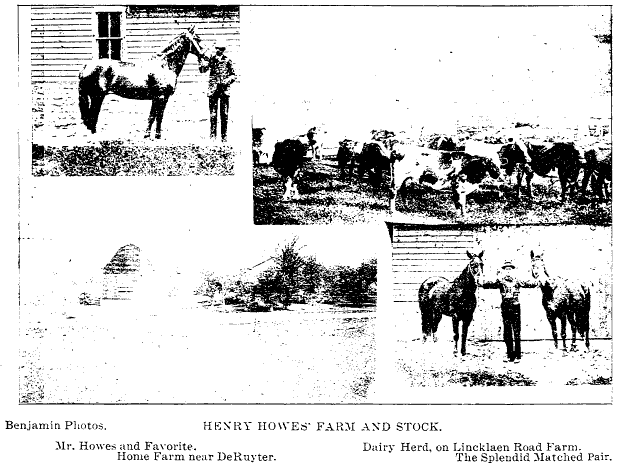
The Epworth League, Chapter No. 6374, M. E. church, was organized Aug. 18, 1891. Miss Frances P. Draper (afterward Mrs. Dr. Wells of Plainfield, N. J.,) was the first president and was largely instrumental in the forming of the Epworth league from the former Young People's society, which had been sustained in the church for a number of years. The Epworth league is one of the strongest of the church societies, the work being thoroughly planned and carried out by an efficient corps of officers. Financially it has been one of the strong arms of the church. In 1896 the league became responsible for the securing and paying the sexton for the year. In 1897, through the personal efforts of the president, Mrs. S. W. Fiske, nearly one hundred dollars was raised for the thorough renovating of the interior of the church. This present year funds are being raised to support and educate a boy in India. The regular devotional services are held one hour previous to the preaching service on Sunday evening and the business meeting occurs the first Tuesday evening of each month, and at present the Literary department has arranged for a short literary program at each monthly meeting. The Epworth league celebrated the eleventh anniversary, May 15, 1900, by holding a "Birthday Party," to which a large number of former members and friends kindly responded. Only two deaths have occurred during the nine years, the first was the president, Mrs. Frances Wells, who died in Plainfield, N. J., and the recent loss of George H. Hayes, for whom the league held a "Memorial service" on Sunday evening, April 29, 1900. The present officers are: Pres., Frank Connell; First Vice (spiritual), Mary Hollenbeck; Second Vice (mercy and help), Millie Preston; Third Vice (literary), Jessie White; Fourth Vice (social), Mrs. S. W. Fiske; Sec., Anna Lyon; Treas., J. O. Griffith.
The Ladies' Aid Society, First Baptist church, was organized in the early forties. On July 10, 1884, the society was reorganized, under the name of the Ladies United Aid Society, taking in ladies from other denominations. At this time a great deal was accomplished by the society, the church was remodeled, newly furnished and in March, 1889, was re-dedicated. The officers were: Mrs. E. D. Reed, president; Mrs. I. Highley, vice-president; Miss Jennie Spear, secretary and Mrs. N. T. Coleman, treasurer. In December, 1896, the society was again reorganized under the name of the Ladies Aid Society of the First Baptist church. The present officers are: Mrs. Monroe Cone, president; Miss Ella Vincent, Mrs. Duane Benjamin, Miss Nettie Ellis, vice-presidents; Miss Alice Clark, secretary; Mrs. James Carrington, treasurer.
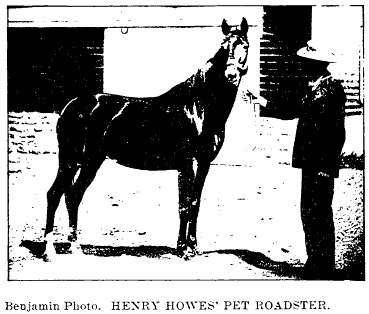 District Attorneys [Appointed]:---Daniel Kellogg, Sullivan, Feb. 30, 1809; Thomas H. Hubbard, Hamilton, Feb. 26, 1816; William K. Fuller, Chittenango, March 26, 1821; Philo Gridley, Hamilton, 1829; Justin Dwinnelle, Cazenovia, 1837; Charles Mason, Hamilton, 1845. [Elected]:---Henry C. Goodwin, Hamilton, 1847; W. E. Lansing, Chittenango, November, 1850; D. J. Mitchell, Hamilton, 1853; A. C. Stone, Peterboro, 1856; A. N. Sheldon, Hamilton, 1859; D. W. Cameron, Cazenovia, 1862; Lambert B. Kern, DeRuyter, 1865; A. Cramphin, Morrisville, 1868; G. A. Forbes, Canastota, 1871; S. B. Daboll, Brookfield, 1874; John E. Smith, Morrisville, 1877; Henry Barclay, Morrisville, 1880; John E. Smith vice Barclay resigned, 1882; Edgar N. Wilson, Cazenovia, 1883; Henry M. Aylesworth, Leonardsville, 1889; J. D. Senn, Morrisville, 1893; Michael H. Kiley, Cazenovia, 1894.
District Attorneys [Appointed]:---Daniel Kellogg, Sullivan, Feb. 30, 1809; Thomas H. Hubbard, Hamilton, Feb. 26, 1816; William K. Fuller, Chittenango, March 26, 1821; Philo Gridley, Hamilton, 1829; Justin Dwinnelle, Cazenovia, 1837; Charles Mason, Hamilton, 1845. [Elected]:---Henry C. Goodwin, Hamilton, 1847; W. E. Lansing, Chittenango, November, 1850; D. J. Mitchell, Hamilton, 1853; A. C. Stone, Peterboro, 1856; A. N. Sheldon, Hamilton, 1859; D. W. Cameron, Cazenovia, 1862; Lambert B. Kern, DeRuyter, 1865; A. Cramphin, Morrisville, 1868; G. A. Forbes, Canastota, 1871; S. B. Daboll, Brookfield, 1874; John E. Smith, Morrisville, 1877; Henry Barclay, Morrisville, 1880; John E. Smith vice Barclay resigned, 1882; Edgar N. Wilson, Cazenovia, 1883; Henry M. Aylesworth, Leonardsville, 1889; J. D. Senn, Morrisville, 1893; Michael H. Kiley, Cazenovia, 1894.
Woman's Home Missionary Society, M. E. church, was organized by the conference secretary, Mrs. W. H. York, of Oneida, Sept. 1892, Mrs. O. A. Retan being elected the first president. The conference in October took Mrs. Retan away, and at the first regular meeting Mrs. S. W. Fiske was elected president which office she filled for three years. The regular meetings are held on the first Thursday of each month and tea meetings held quarterly. The present officers are: President, Mrs. G. W. Rosenberry; vice-president, Mrs. Geo. Hayes; secretary, Mrs. W. E. Burdick; treasurer, Mrs. E. A. Warner.
The Y. P. S. C. E., Seventh Day Baptist church, was organized Jan. 28, 1890, after a series of special meetings held in the First Baptist church. The first officers elected were: President, Rev. L. R. Swinney; secretary and treasurer, Etta J. Phillips. A constitution was drawn up by the president and adopted by the society. After a short time, the "Model Constitution" was adopted. The money derived from entertainments has been devoted yearly to missionary work at home and abroad. The officers at the present time are: President, Frank Phillips; vice-president, Bertha Annas; treasurer, Neil Annas; organist, Bertha Annas.
Fire of '99.---In the afternoon of April, 26, 1899, fire destroyed the shops and sheds of the Cazenovia Coal and Lumber Co., the furniture store of I. E. Smith and the barns and ice house of Mrs. S. M. Crumb, located in a group on the north side of Albany street next to the creek. The Pooler house and barn, the building occupied by I. E. Smith and Mrs. A. Burdick, and J. E. Rouse's house were damaged, all of these buildings being saved only by the efficiency of the firemen and the splendid water system. Mrs. Crumb's residence was badly damaged. 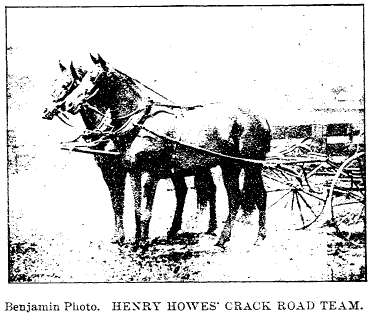 The buildings occupied by the lumber company were a story and a half building with the gable end to the street, once used as a foundry, detached lumber sheds and an old machine shop used for storing sash, blinds and lath. Dense clouds of black smoke first gave evidence of the fire. For a time residences across the street were threatened and the occupants moved out. It was a $12,000 fire.
The buildings occupied by the lumber company were a story and a half building with the gable end to the street, once used as a foundry, detached lumber sheds and an old machine shop used for storing sash, blinds and lath. Dense clouds of black smoke first gave evidence of the fire. For a time residences across the street were threatened and the occupants moved out. It was a $12,000 fire.
The Sewing Society, Seventh Day Baptist church, was organized in 1853. The membership fee was one shilling and the weekly contributions one penny. The society met at 1 P. M. and adjourned at 5 P. M. to give its members opportunity to prepare supper at home. Later, persons in poor health and those living at a distance, were invited to remain to tea. Mrs. Chas. H. Maxson and Mrs. B. G. Stillman were elected presidents, Mrs. M. M. Peasley secretary and Mrs. J. R. Irish, treasurer. Mrs. H. C. Coon, Mrs. Horace Burdick, Mrs. S. M. Burdick, Mrs. Arza Coon and Mrs. L. H. Babcock were directors. Of the sixty-seven whose names appear on that roll, only six are living at the present time. In 1869 the society was reorganized under the name of the Mite society, and Mrs. Joshua Clarke was chosen president. This organization raised money for the purchase of a bell for the church, for repairing, refurnishing and painting on the outside, besides helping to pay for a new organ, and making a yearly payment on the pastor's salary. In 1896 the constitution was again revised and the name, Woman's Benevolent Society, adopted as being more expressive of the nature of the organization. In addition to looking after all the interests before mentioned it aims to contribute a stated sum for tract, missionary and educational work.
John and Sarah Hunt, who were married Dec. 9, 1869, went to live on the old Hunt homestead at Quaker Basin that same year. There they remained about eighteen years, a happy, prosperous and greatly respected couple. In October, 1887, they bought a place in a very pretty part of Utica street, DeRuyter, where they died about two months apart, John's death occurring Sept. 5, 1899, and his wife's Nov. 28, 1899. Mr. and Mrs. Connell who went to live on the farm in 1884 took up their residence in the village of DeRuyter in Feb. 1899, in order to care for Mr. and Mrs. Hunt, who were Mrs. Connell's parents. After the death of the elderly couple their two farms and the Quaker Basin butter factory, in which Mr. Hunt owned a controlling interest, but which had been largely managed by Mr. Connell for some time before that, were left entirely in his control. Both farms are at Quaker Basin, the homestead at the west end and the other place at the east. The latter was the Adams place bought by Mr. Hunt shortly before he died. The former came into the family in 1841, the property of William Hunt, his father, who disposed of it in 1866 when he moved to Pompey Hollow. Mr. Charles Hunt, a brother to John, afterwards bought it and it has since passed down in the family to Mrs. Connell, the present owner. Mr. and Mrs. Connell were married Nov. 21, 1883, and their only child is Bessie S., who was born Sept. 20, 1887.
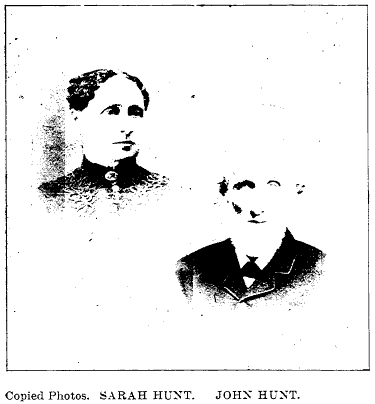
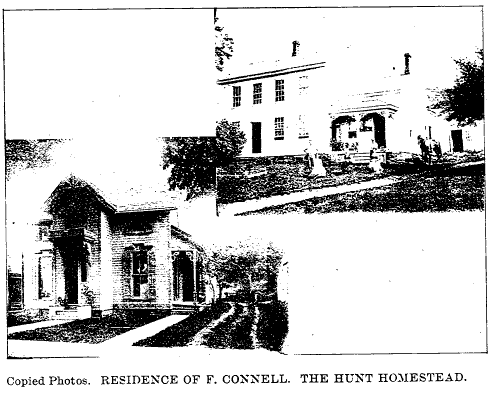
They are accustomed to large farming and there will be no change in the details of the late Mr. Hunt's interests. Mr. Connell was born in DeRuyter Nov. 5, 1862, and Mrs. Connell's birth was in the same town on June 3, 1859. Both entertain a deep interest greater than property values command, in the old family home and the associations that cluster about it. Mr. Connell is a member of the DeRuyter Lodge F. & A. M. and the grange. Both are prominent members of the M. E. church. Mr. John Hunt, while not an avowed Quaker himself, was descendant of a line of Quakers reaching back to the arrival in Massachusetts of seven Quaker brothers. The son of one of them was James Hunt, the paternal grandfather of John, who settled in DeRuyter in 1813, coming here from Cambridge, Washington county, where William Hunt, the next to the youngest of his eight children was born Jan. 30, 1801. William was twelve years old when his father hewed out of the dense forests on Quaker Hill a home for his large family. He married Elizabeth, daughter of Zephaniah and Hannah Breed, then living in Harford, Cortland county. They lived on Quaker Hill a short time before William bought the farm at Quaker Basin. A few years later he rebuilt the house---that which is standing to-day. He was a prominent supporter of the old Quaker Basin church and widely known. He died at Pompey Hollow Feb. 10, 1888, surviving his wife for more than twelve years, her death having occurred Dec. 29, 1875. John Hunt was born in the town of DeRuyter March 1, 1826, and was the oldest of nine children. Those who survive him are Charles of Delphi, James of DeRuyter, (see sketch of James Hunt), Mary (Mrs. Frank Drake) of Georgetown, N. Y., and Hannah (Mrs. Henry Carpenter) of Manlius, N. Y. William Edwin met his death on the battlefield in "the war of '61." On Sept. 23, 1852, John Hunt married Sarah, the daughter of Davis and Elizabeth Wright of DeRuyter. Mr. Hunt's two daughters came from this marriage. She died at Pompey Hollow July 19, 1868. The second wife who accompanied Mr. Hunt to the end of his journey---a period of thirty years---but who gave him no children, was the widow of Milan Harrington, who died at Richford, Tioga county, and the daughter of Seneca and Margaret Howard who settled in Harford, Cortland county at an early period.
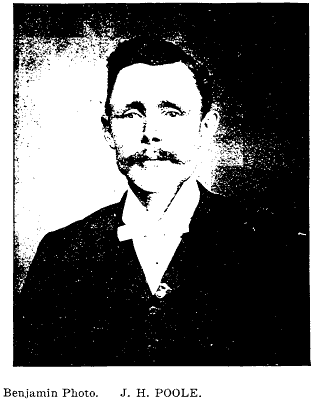 James H. Poole was admitted to the practice of law at the general term in Syracuse Nov. 20, 1891, after taking a regular law course at Cornell university where he was graduated with honors in June of that year. During the period subsequent to his admission to the bar from 1891 to Jan. 1896, he was located at DeRuyter in the office of Lambert B. Kern. Then he opened his present office in the old Parsons bank building on Utica street and has followed a general practice of law ever since. He was born March 20, 1866, in the town of Fabius, Onondaga county, and attended the district schools in Cortland and Madison counties. Later he was a student at DeRuyter institute where he was graduated in June, 1889. During the time he attended that institution he served as a clerk in the postoffice at DeRuyter, taught school one term and studied law. In politics he is a thorough, active Democrat, being a member of the town committee with which he has been identified six or seven years. On June 12, 1895, he was married to Irene Samson of DeRuyter. He is a member of the Masonic order. William H. Poole, his father, has been a resident of the town of DeRuyter and vicinity all of his life and is prominent in agricultural societies. For several years he was engaged in business in this village. He is also well known for his life-long, sterling Democracy.
James H. Poole was admitted to the practice of law at the general term in Syracuse Nov. 20, 1891, after taking a regular law course at Cornell university where he was graduated with honors in June of that year. During the period subsequent to his admission to the bar from 1891 to Jan. 1896, he was located at DeRuyter in the office of Lambert B. Kern. Then he opened his present office in the old Parsons bank building on Utica street and has followed a general practice of law ever since. He was born March 20, 1866, in the town of Fabius, Onondaga county, and attended the district schools in Cortland and Madison counties. Later he was a student at DeRuyter institute where he was graduated in June, 1889. During the time he attended that institution he served as a clerk in the postoffice at DeRuyter, taught school one term and studied law. In politics he is a thorough, active Democrat, being a member of the town committee with which he has been identified six or seven years. On June 12, 1895, he was married to Irene Samson of DeRuyter. He is a member of the Masonic order. William H. Poole, his father, has been a resident of the town of DeRuyter and vicinity all of his life and is prominent in agricultural societies. For several years he was engaged in business in this village. He is also well known for his life-long, sterling Democracy.
Christian Endeavor Society, Congregational church, was organized Jan. 15, 1897, by Mrs. C. Bull, wife of our pastor, Rev. D. W. Bull, with fifteen active and seventeen associate members. Mrs. C. Bull, president; Miss C. Mitchell, vice-president; Miss Dora Bull, secretary; Miss Maud DeLong, treasurer. The work which has been encouraging and helpful to the church from the beginning is carried on through six departments with their several committees. Devotional meetings are held every Sunday evening, one hour before the regular preaching service. Regular business is conducted once a month. The officers for the year 1900 are: Mrs. Ida Hill, president; Miss Josephine Mitchell, vice-president; Mrs. M. A. Ford, secretary; Miss Louis DeLamater, treasurer. The society has contributed in many ways in helping to furnish the church and assisting to pay the pastor's salary and by placing three fine windows in the church parlors, also by helping to support our foreign missionary, Mr. Taylor, in Africa; also bearing their share of all church work, fully realizing their dependence on Divine Providence and the support of their pledge---Trusting in the Lord Jesus Christ, and are endeavoring to lead a Christian life encouraged by the support and co-operation of their pastor, Rev. D. W. Bull.
Early fires---Five conflagrations are on record in the history of DeRuyter. In other places will be found descriptions of the "Fire of '58," "Fire of '90" and "Fire of '99." In about '60 or '61 Mathew Williams' store and J. W. Clark's hotel barn were burned. On the morning of Dec. 26, 1878, fire destroyed G. F. Annas & Co.'s hardware store, A. N. Annas' dwelling, the town building, J. P. Russell's store and L. B. Kern's law office. This loss was $20,000.
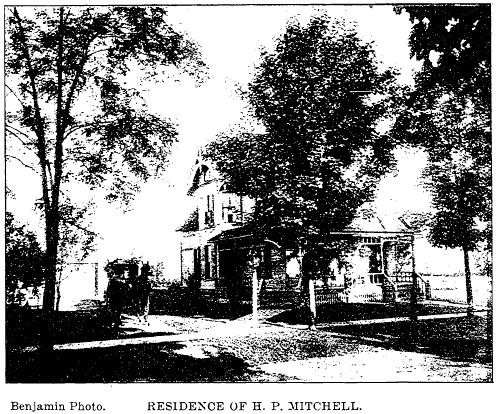
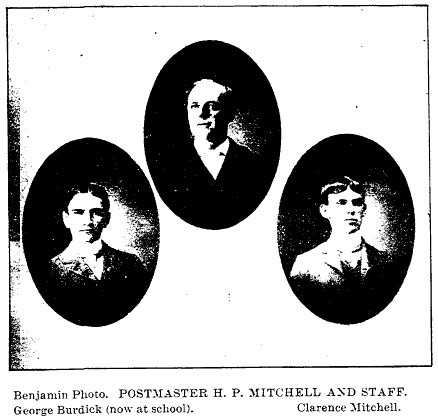
Henry P. Mitchell, the postmaster of DeRuyter, received his commission by the appointment of President McKinley Dec. 20, 1898, and took possession of the office January 1, 1899. He was town clerk one term and at the present time is a member of the school board, an office which he has held nine years. He has been for three terms a village trustee. He is prominently identified with the Republican Party in the town. 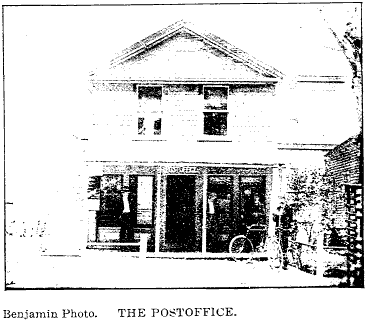 During the first year of his incumbency the postoffice did a business of over two hundred dollars in excess of any previous year. Daniel Q. Mitchell, his father, represented the Home Insurance company for twenty years and upon his death which occurred Feb. 4, 1881, the agency for the company went into the hands of his son, so that next February this agency will have been in the family forty years. Mr. Daniel Mitchell was born in DeRuyter, his father, Oliver Mitchell, being one of the early settlers in the village and a large land owner. The site of the Seventh Day Baptist church was donated by him for that purpose. Daniel Mitchell was a prominent lawyer, a leading man of the town and during the war was in the enlistment office at Oswego. His brother, D. J. Mitchell, was a prominent lawyer at Syracuse. Aaron and George H. Mitchell were his brothers. The latter, who is in the wholesale house of Dunham, Buckley & Co. of New York, with whom he has been for several years, is the sole survivor of the brothers. Lydia Manchester of Hamilton is a sister. Mr. H. P. Mitchell has been successful in the insurance business, having worked up a large business from a small beginning and from time to time has added new companies to his agency until now he represents seven of the leading fire companies, including the Hartford, which he has had for eighteen years, and one life insurance company. He has always been among those who are identified with local enterprises. He was one of the organizers of the DeRuyter driving park and agricultural society and during the past seven years has been its secretary. He was one of the reorganizers of the cemetery association which took the institution when its affairs were at low ebb and bought and laid out new grounds and placed it on a paying basis. Mr. Mitchell was born March 24, 1854, in DeRuyter and was educated in the schools of this village. During the six years preceding his father's death he traveled for a Rochester nursery firm and during the earlier period of his life he clerked in different places including two years in New York. He was also in business in Chicago for awhile. On Dec. 23, 1879, he married Elsie V., the daughter of Charles W. Brown, an old resident of DeRuyter. They have one son, Clarence D., who is the assistant postmaster.
During the first year of his incumbency the postoffice did a business of over two hundred dollars in excess of any previous year. Daniel Q. Mitchell, his father, represented the Home Insurance company for twenty years and upon his death which occurred Feb. 4, 1881, the agency for the company went into the hands of his son, so that next February this agency will have been in the family forty years. Mr. Daniel Mitchell was born in DeRuyter, his father, Oliver Mitchell, being one of the early settlers in the village and a large land owner. The site of the Seventh Day Baptist church was donated by him for that purpose. Daniel Mitchell was a prominent lawyer, a leading man of the town and during the war was in the enlistment office at Oswego. His brother, D. J. Mitchell, was a prominent lawyer at Syracuse. Aaron and George H. Mitchell were his brothers. The latter, who is in the wholesale house of Dunham, Buckley & Co. of New York, with whom he has been for several years, is the sole survivor of the brothers. Lydia Manchester of Hamilton is a sister. Mr. H. P. Mitchell has been successful in the insurance business, having worked up a large business from a small beginning and from time to time has added new companies to his agency until now he represents seven of the leading fire companies, including the Hartford, which he has had for eighteen years, and one life insurance company. He has always been among those who are identified with local enterprises. He was one of the organizers of the DeRuyter driving park and agricultural society and during the past seven years has been its secretary. He was one of the reorganizers of the cemetery association which took the institution when its affairs were at low ebb and bought and laid out new grounds and placed it on a paying basis. Mr. Mitchell was born March 24, 1854, in DeRuyter and was educated in the schools of this village. During the six years preceding his father's death he traveled for a Rochester nursery firm and during the earlier period of his life he clerked in different places including two years in New York. He was also in business in Chicago for awhile. On Dec. 23, 1879, he married Elsie V., the daughter of Charles W. Brown, an old resident of DeRuyter. They have one son, Clarence D., who is the assistant postmaster.
Fire of '90---On the morning of April 24, 1890, fire was discovered in the rear of Smith & Fiske's store on the southeast corner of Albany and Lincklaen streets in the Merchant Block. In six minutes the firemen had a stream directed on the blaze. Water was then taken from small cisterns built for fire purposes. The flames were apparently under control when the reservoir gave out, and the engine had to be moved elsewhere. This gave time for a revival of the flames with the result of the complete destruction of three business blocks, three residences and a barn. The fire was discovered by Mrs. W. W. Ames, wife of the editor of the Gleaner and the latter clad only in his night garment ran to the firebell and gave the alarm. Besides the business firms who suffered from the fire eight families were turned into the street, viz: G. A. Spaulding, J. H. Babcock, Geo. Samson, James Burtis, Silas Stillman, Henry Nott, L. C. Coon and Jashup Weaver. The list of sufferers and losses are as follows: Smith & Fiske, general store, $22,200; C. J. York, store, $10,000; Rider & Blye, $1,400; H. C. Miner, $3,000; J. Carrington, $1,500; G. A. Spaulding, $800; H. S. Walker, $1,025; H. J. Reed, $200; F. E. Tallett, $175; Mrs. J. Spear, $200; F. & A. M., $600; A. O. U. W., $280; E. H. Lee, $400; J. E. Rouse, $100; R. F. Clark, $100; W. W. Ames, $200; O. M. Blanchard, $25; Jesse Stillman, $500; Dr. S. S. Clark, $1,000; Henry Nott, $275.
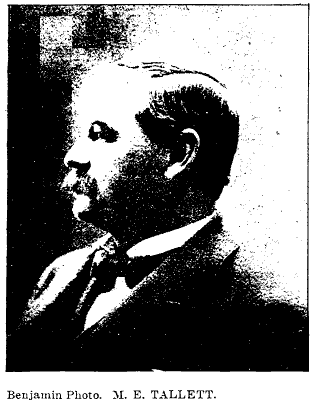
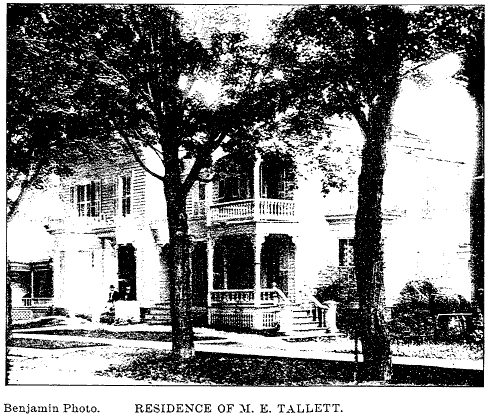
Morrell E. Tallett is one of the largest buyers of potatoes and apples in this part of Madison county. His interest in the development of the village and the expansion of local trade has led him to support any legitimate proposition intended to foster local enterprise. In March, 1879, he came to DeRuyter, accepting the position of agent for the Lehigh Valley railroad. He bought the coal business then carried on by J. H. Crumb and erected a building with trestle to accommodate it. To secure the required accommodations for his produce business he constructed a storehouse opposite the railroad station which has a capacity for the storage of 7,000 bushels of potatoes and two or three carloads of apples. At one time this business was increased to the extent that he handled yearly more produce than had previously been handled in the village. A good deal of his shipments are made at adjacent railroad stations. In addition to coal he sells lime, plaster, cement and brick. He has dealt in and is a great admirer of high bred horses; and he is the owner of a fine team which he highly values. When the DeRuyter Banking company was organized, of which he was one of the incorporators, he was chosen the vice-president and a director, which positions he has held since then. He is also high in masonry, being a member of the DeRuyter lodge, the Cortland Chapter and Commandery and the Utica shrine. Being a staunch and unwavering supporter of the Republican party, he closely affiliated with the leaders throughout the county and was one of the organizers of the party symposium known as the Madison County Social club of which he is one of the directors. Mr. Tallett was born in Otselic, Chenango county, April 10, 1850, where he resided until his removal to DeRuyter. John J. Tallett, his father, who came to that town from Brookfield, Madison county, lived and died a farmer, greatly respected by all who knew him. Morrell E. Tallett received his education in the district school and the DeRuyter institute. Afterwards taught several terms. In 1872 he accepted the position of agent for the Norwich and DeRuyter branch of the old Oswego Midland (N. Y., O. & W.) railroad, and it was then he began the business of buying and selling produce and coal. On March 4, 1873, co-incident with the inauguration of President Grant for a second term, he was united in marriage with Nellie A., the daughter of Alden Mason of Otselic. Mr. and Mrs. Tallett own and occupy the large residence formerly the property of Lambert B. Kern, a charming village home.
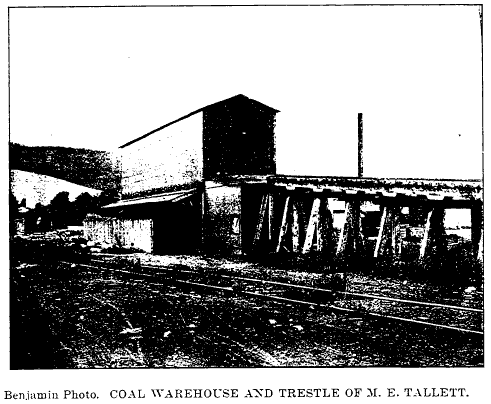 The Fire of '58 [for other conflagrations see "Early Fires;" also "Fire of '90" and "Fire of '99"] started in the Annas hotel barn which, together with three other buildings, was destroyed. Those burned out were: Three story brick block, Mathew Williams' grocery and saloon and Frank Taylor's harness shop and residence; three story stone double building---Lafayette block---W. J. Ayer, hardware, and George and Deloss Sears general store; Gage residence. While the goods were being removed a lumber wagon drove up and the men were told to place goods in it. When this was done the wagon and goods disappeared, and were never seen again. The total loss was about $15,000.
The Fire of '58 [for other conflagrations see "Early Fires;" also "Fire of '90" and "Fire of '99"] started in the Annas hotel barn which, together with three other buildings, was destroyed. Those burned out were: Three story brick block, Mathew Williams' grocery and saloon and Frank Taylor's harness shop and residence; three story stone double building---Lafayette block---W. J. Ayer, hardware, and George and Deloss Sears general store; Gage residence. While the goods were being removed a lumber wagon drove up and the men were told to place goods in it. When this was done the wagon and goods disappeared, and were never seen again. The total loss was about $15,000.
Ezra Cornell, founder of Cornell university, grew up a tall, lean, bashful country boy, on Crumb Hill, town of DeRuyter. The old home which he built with his own hands, stands on the brow of the mountain in plain view from the streets of DeRuyter, four miles distant, a wrecked deserted building. The pottery which stood near the door-yard entrance when in use years ago, is now a part of the tumble down barns. The grandest prospect and dearest associations impress the visitor. The old place should be preserved by the county historical society. Rev. L. R. Swinney writing to the Souvenir says that Ezra's parents, Elijah and Eunice, followed through life the style and speech of the Society of Friends. Also that after marriage, (July 4, 1805) Elijah engaged in ship building for awhile, then moved to DeRuyter and settled on Crumb Hill. Subsequently he lived at Westchester Landing, Westchester county, where Ezra was born, Jan. 11, 1807, and in 1819 returned to Crumb Hill locating on the place still known as the "Cornell place." Here Elijah made pottery which he sold in the adjacent section and the neighboring villages.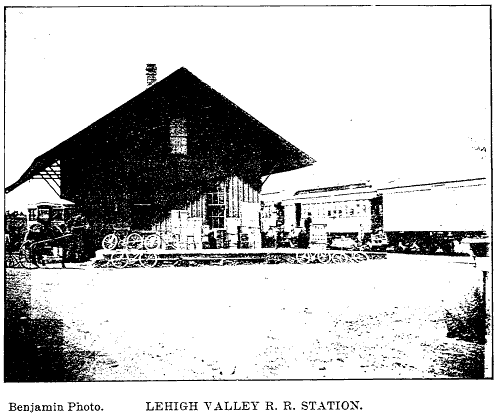 On the brow of the hill, with a charming view of Quaker Basin and the valley south, was a log dwelling and there Mr. Cornell put up a large log building for his extensive pottery trade. When Ezra was seventeen years old he planned the frame of a dwelling house which was so admirably done, to the astonishment of the neighbors, that he was henceforth looked upon as the "coming man" of the whole community. This house when completed was the best in the town of DeRuyter and the first frame house on the hill. In the old schoolhouse south of the present one and in the devout meetings at Quaker Basin, Ezra received his intellectual and religious training. He was a very apt scholar with a fondness for mathematics and skillful in all mechanical contrivances and through life an upright, noble man. He was strong and muscular, standing six feet high and seemed to have a prodigious capacity for hard work. While still a boy he took and cleared four acres of heavy beech timber so he could go to school one whole winter and pay his own expenses. With a worthy ambition at eighteen he went to the hamlet of Syracuse and cut timber for the canal trade, then worked in Homer and finally went to Ithaca on foot, which was his usual way of traveling. Here he labored and saved and helped build up the village till the financial crisis of 1837 threw him out of employment. He was married to Mary Ann Wood in Dryden, N. Y., March 19, 1831, and henceforth his wife was his worthy helpmeet and companion. His wife not being of the Friends persuasion his name was excluded from the Society of Friends, but Ezra continued through life a quiet believer in the faith of his parents.
On the brow of the hill, with a charming view of Quaker Basin and the valley south, was a log dwelling and there Mr. Cornell put up a large log building for his extensive pottery trade. When Ezra was seventeen years old he planned the frame of a dwelling house which was so admirably done, to the astonishment of the neighbors, that he was henceforth looked upon as the "coming man" of the whole community. This house when completed was the best in the town of DeRuyter and the first frame house on the hill. In the old schoolhouse south of the present one and in the devout meetings at Quaker Basin, Ezra received his intellectual and religious training. He was a very apt scholar with a fondness for mathematics and skillful in all mechanical contrivances and through life an upright, noble man. He was strong and muscular, standing six feet high and seemed to have a prodigious capacity for hard work. While still a boy he took and cleared four acres of heavy beech timber so he could go to school one whole winter and pay his own expenses. With a worthy ambition at eighteen he went to the hamlet of Syracuse and cut timber for the canal trade, then worked in Homer and finally went to Ithaca on foot, which was his usual way of traveling. Here he labored and saved and helped build up the village till the financial crisis of 1837 threw him out of employment. He was married to Mary Ann Wood in Dryden, N. Y., March 19, 1831, and henceforth his wife was his worthy helpmeet and companion. His wife not being of the Friends persuasion his name was excluded from the Society of Friends, but Ezra continued through life a quiet believer in the faith of his parents.
There were 13,106 visitors to our previous host from 5 Apr 2005 to 25 Aug 2011.
© Tim Stowell 2005-2011